- Society and Politics
- Art and Culture
- Biographies
- Publications


Great Trek 1835-1846
The Great Trek was a movement of Dutch-speaking colonists up into the interior of southern Africa in search of land where they could establish their own homeland, independent of British rule. The determination and courage of these pioneers has become the single most important element in the folk memory of Afrikaner Nationalism. However, far from being the peaceful and God-fearing process which many would like to believe it was, the Great Trek caused a tremendous upheaval in the interior for at least half a century.
The Voortrekkers
The Great Trek was a landmark in an era of expansionism and bloodshed, of land seizure and labour coercion. Taking the form of a mass migration into the interior of southern Africa, this was a search by dissatisfied Dutch-speaking colonists for a promised land where they would be 'free and independent people' in a 'free and independent state'.
The men, women and children who set out from the eastern frontier towns of Grahamstown, Uitenhage and Graaff-Reinet represented only a fraction of the Dutch-speaking inhabitants of the colony, and yet their determination and courage has become the single most important element in the folk memory of Afrikaner nationalism. However, far from being the peaceful and God-fearing process which many would like to believe it was, the Great Trek caused a tremendous social upheaval in the interior of southern Africa, rupturing the lives of hundreds of thousands of indigenous people. But this time the reports that reached the chiefs of the Sotho clans on the northern bank were more alarming: the white men were coming in their hundreds.
Threatened by the 'liberalism' of the new colonial administration, insecure about conflict on the eastern frontier and 'squeezed out' by their own burgeoning population, the Voortrekkers hoped to restore economic, cultural and political unity independent of British power. The only way they saw open to them was to leave the colony. In the decade following 1835, thousands migrated into the interior, organised in a number of trek parties under various leaders. Many of the Voortrekkers were trekboers (semi-nomadic pastoral farmers) and their mode of life made it relatively easy for them to pack their worldly possessions in ox-wagons and leave the colony forever.
After crossing the Orange River the trekkers were still not totally out of reach of the Cape judiciary - in terms of the Cape of Good Hope Punishment Act (1836), they were liable for all crimes committed south of 25 deg latitude (which falls just below the present-day Warmbaths in northern Transvaal).
The trekkers had a strong Calvinist faith. But when the time came for them to leave they found that no Dutch Reformed Church minister from the Cape was prepared to accompany the expedition, for the church synod opposed the emigration, saying it would lead to 'godlessness and a decline of civilisation'. So the trekkers were forced to rely on the ministrations of the American Daniel Lindley, the Wesleyan missionary James Archbell, and a non-ordained minister, Erasmus Smit.
The trekkers, dressed in traditional dopper coats (short coats buttoned from top to bottom), kappies (bonnets) and hand-made riempieskoene (leather thong shoes), set out in wagons which they called kakebeenwoens (literally, jawbone wagons, because the shape and sides of a typical trek wagon resembled the jawbone of an animal).
These wagons could carry a startling weight of household goods, clothes, bedding, furniture, agricultural implements, fruit trees and weapons. They were ingeniously designed and surprisingly light, so as not to strain the oxen, and to make it easier to negotiate the veld, narrow ravines and steep precipices which lay ahead. Travelling down the 3500 metre slope of the Drakensberg, no brake shoe or changing of wheels could have saved a wagon from hurtling down the mountain were it not for a simple and creative solution: the hindwheels of wagons were removed and heavy branches were tied securely underneath. So the axles were protected, and a new form of brake was invented.
The interior represented for the trekkers a foreboding enigma. The barren Kalahari Desert to the west of the highveld, and the tsetse fly belt which stretched from the Limpopo River south-eastwards, could not have been a very inviting prospect. Little did they realise that neither man nor animal would escape the fatal malarial mosquito. Yet the Voortrekkers ploughed on through treacherous terrain, eliminating all obstacles in their path, and intent on gaining access to ports beyond the sphere of British control, such as Delagoa Bay, Inhambane and Sofala. In order for their new settlement to be viable, it was crucial that they make independent links with the economies of Europe.
Trek and the 'empty lands'
The Empty Land Myth The Empty or Vacant Land Theory is a theory was propagated by European settlers in nineteenth century South Africa to support their claims to land. Today this theory is described as a myth, the Empty Land Myth, because there is no historical or archaeological evidence to support this theory. Despite evidence to the contrary a number of parties in South Africa, particularly right-wing nationalists of European descent, maintain that the theory still holds true in order to support their claims to land-ownership in the country. Read article
Reconnaissance expeditions in 1834 and 1835 reported that Natal south of the Thukela and the central highveld on either side of the Vaal River, were fertile and largely uninhabited, much of the interior having been unsettled by the ravages of the Mfecane (or Difaqane as it is called in Sotho). The truth of these reports - many of them from missionaries - has long been a source of argument among historians, and recent research indicates that the so-called 'depopulation theory' is unreliable - the devastation and carnage by African warriors is exaggerated with every account, the number of Mfecane casualties ranging between half a million and 5-million.
This kind of historical inaccuracy strengthens the trekkers' claim that the land which they occupied was 'uninhabited and belonged to no-one', that the survivors of the Mfecane were conveniently spread out in a horseshoe shape around empty land. Probably in an attempt to justify their land seizure, the trekkers also claimed to have actually saved the smaller clans in the interior from annihilation, and defeated the 'barbarous' Ndebele and Zulu warriors.
Africans did indeed move temporarily into other areas, but were soon to reoccupy their land, only to find themselves ousted by Boer intruders. For example, in Natal the African population, estimated at 11000 in 1838, was increased by 'several thousand refugees' after Dingane's defeat at the hands of his half-brother Mpande two years later. In 1843, when the Republic of Natalia was annexed by the British, the official African population was put at 'between 80 000 and 10 0000 people'. But even this may have been an underestimation.
Trekker communities and technology
Military prowess was of paramount importance to the trekker expedition. It had to be, for they were invading and conquering lands to which African societies themselves lay claim. Bound by a common purpose, the trekkers were a people's army in the true sense of the word, with the whole family being drawn into military defence and attack. For instance, the loading of the sanna (the name they gave to the muzzle-loading rifles they used) was a complicated procedure and so the Boers used more than one gun at a time - while aiming and firing at the enemy with one, their wives and children would be loading another.
Armed with rifles on their backs and a kruithoring (powder horn) and bandolier (a bullet container made of hartebeest, kudu or ox-hide) strapped to their belts, formidable groups of trekkers would ride into battle. Bullets were often sawn nearly through to make them split and fly in different directions, and buckshot was prepared by casting lead into reeds and then chopping it up. Part of every man's gear was his knife, with a blade about 20 centimetres in length. When approaching the battlefield, the wagons would be drawn into a circle and the openings between the wheels filled with branches to fire through and hide behind. When they eventually settled down, the structure of many of the houses they built - square, with thick walls and tiny windows - resembled small fortresses.
The distinction between hunting and raiding parties was often blurred in trekker society. Killing and looting were their business, land and labour their spoils. When the trekkers arrived in the Transvaal they experienced an acute labour shortage. They did not work their own fields themselves and instead used Pedi who sold their labour mainly to buy arms and ammunition.
During commando onslaughts, particularly in the eastern Transvaal, thousands of young children were captured to become inboekselings ('indentured people'). These children were indentured to their masters until adulthood (the age of 21 in the case of women and 25 in the case of men), but many remained bound to their masters for much longer. This system was akin to child slavery, and a more vicious application of the apprenticeship laws promulgated at the Cape in 1775 and 1812.
Child slavery was even more prevalent in the northern Soutpansberg area of the Transvaal. It has been suggested that when these northern Boers could no longer secure white ivory for trade at Delagoa Bay, 'black ivory' (a euphemism widely used for African children) began to replace it as a lucrative item of trade. Children were more amenable to new ways of life, and it was hoped that the inboekselings would assimilate Boer cultural patterns and create a 'buffer class' against increasing African resistance.
Dispossession and land seizure
The trekkers' first major confrontation was with Mzilikazi, founder and king of the Ndebele. After leaving the Cape, the trekkers made their first base near Thaba Nchu, the great place of Moroka, the Rolong chief. In 1836 the Ndebele were in the path of a trekker expedition heading northwards and led by Andries Hendrik Potgieter. The Ndebele were attacked by a Boer commando led by Potgieter, but Mzilikazi retaliated and the Boers retreated to their main laager at Vegkop. There in October, in a short and fierce battle which lasted half an hour, 40 trekkers succeeded in beating off an attack by 6000 Ndebele warriors. Both sides suffered heavy losses - 430 Ndebele were killed, and the trekkers lost thousands of sheep and cattle as well as their trek oxen. But a few days later, Moroka and the missionary Archbell rescued them with food and oxen.
Gert Maritz and his party joined these trekkers in Transorangia (later the Orange Free State) and in January 1837, with the help of a small force of Griqua, Kora, Rolong and Tlokwa, they captured Mzilikazi 's stronghold at Mosega and drove the Ndebele further north. The trekkers then concluded treaties of friendship with Moroka and Sekonyela (chief of the Tlokwa).
When Piet Retief and his followers split away and moved eastwards to Natal, both Potgieter and Piet Uys remained determined to break the Ndebele. At the end of 1837, 135 trekkers besieged Mzilikazi 's forces in the Marico valley, and Mzilikazi fled across the Limpopo River to present-day Zimbabwe. He died there, to be succeeded by Lobengula, who led a rather precarious life in the area until he was eventually defeated by the forces of the British South Africa Company in the 1890s.
Meanwhile, Retief and his followers continued marching towards Port Natal (later Durban). After Retief's fateful encounter with Dingane, chief of the Zulu, and the ensuing Battle of Blood River, the trekkers declared the short-lived Republic of Natalia (1838). They formed a simple system of goveming, with Pretorius as President, assisted by a volksraad (people's assembly) of 24 members, and local government officials based on the traditional landdrost and heemraden system. In 1841, an adjunct council was established at Potchefstroom, with Potgieter as Chief-Commandant. The trekkers believed that at last they had found a place in the sun....
But the British would not recognise their independence. In December 1838, the Governor, Sir George Napier, a determined military man who had not allowed the loss of his right arm in battle to ruin his career, sent his military secretary, Major Samuel Charters, to occupy Port Natal, which effectively controlled Voortrekker use of the harbour. Three years later, when the Natal Volksraad resolved to drive all Africans not working for the whites southwards beyond the Mtamvuna River (later the border between Natal and the Transkei), Napier again intervened. He was concerned that this would threaten the eastern frontier of the Cape, and so instructed Captain Thomas Charlton Smith to march to Port Natal with 250 men. Smith, who had joined the Royal Navy at the age of nine and was a veteran of the Battle of Waterloo, tried to negotiate with Pretorius, but to no avail.
On the moonlit night of 23 May 1842, Smith attacked the Boer camp at Congella but Pretorius, who had been alerted, fought back. The trekkers proceeded to besiege the British camp. One of their number, Dick King. who became known as the 'saviour of Natal', evaded the siege and rode some 1000 kilometres on horseback to seek reinforcements in Grahamstown. In June a British relief force under Lieutenant-Colonel Abraham Cloete arrived on the scene and Boer resistance was crushed. On 15 July the volksraad at Pietermaritzburg signed the conditions of submission.
Although most trekkers had travelled into Natal or into the far north with the main expeditions, some had remained on the fertile land above the junction of the Caledon and Orange rivers, and gradually began to move north-eastward.
The trekkers' pioneer in this area was Jan de Winnaar, who settled in the Matlakeng area in May-June 1838. As more farmers were moving into the area they tried to colonise the land between the two rivers, even north of the Caledon, claiming that it had been abandoned by the Sotho people. But although some of the independent communities who had lived there had been scattered, others remained in the kloofs and on the hillsides. Moshoeshoe, paramount chief of the Sotho, when hearing of the trekker settlement above the junction, stated that '... the ground on which they were belonged to me, but I had no objections to their flocks grazing there until such time as they were able to proceed further; on condition, however, that they remained in peace with my people and recognised my authority'.
The trekkers proceeded to build huts of clay (instead of reed), and began planting their own food crops (no longer trading with the Sotho). This indicated their resolve to settle down permanently. A French missionary, Eugene Casalis, later remarked that the trekkers had humbly asked for temporary rights while they were still few in number, but that when they felt 'strong enough to throw off the mask' they went back on their initial intention.
In October 1842 Jan Mocke, a fiery republican, and his followers erected a beacon at Alleman's drift on the banks of the Orange River and proclaimed a republic. Officials were appointed to preside over the whole area between the Caledon and Vaal rivers. Riding back from the drift, they informed Chief Lephoi, an independent chief at Bethulie, that the land was now Boer property and that he and his people were subject to Boer laws. They further decided that the crops which had been sown for the season would be reaped by the Boers, and they even uprooted one of the peach trees in the garden of a mission station as indication of their ownership. In the north-east, they began to drive Moshoeshoe's people away from the springs, their only source of water. Moshoeshoe appealed for protection to the Queen of England, but he soon discovered that he would have to organise his own resistance.
Land seizure and dispossession were also prevalent in the eastern Transvaal where Potgieter had founded the towns of Andries-Ohrigstad in 1845 and Soutpansberg (which was later renamed Schoemansdal) in 1848. A power struggle erupted between Potgieter and Pretorius, who had arrived with a new trekker party from Natal and seemed to have a better understanding of the political dynamics of southern Africa. Potgieter, still anxious to legitimise his settlement, concluded a vredenstraktaat (peace treaty) in 1845 with Sekwati, chief of the Pedi, who he claimed had ceded all rights to an undefined stretch of land. The precise terms of the treaty are unknown, but it seems certain that Sekwati never actually sold land to the Boers.
Often in order to ensure their own safety, chiefs would sign arbitrary treaties giving away sections of land to which they in fact had no right. Such was the case with Mswati, chief of the Swazi, who, intent on seeking support against the Zulu, in July 1846 granted all the land bounded by the Oliphants, Crocodile and Elands rivers to the Boers. This angered the Pedi, who pointed out that the land had not even been his to hand over.
There was no uniform legal system or concept of ownership to which all parties interested in the land subscribed. Private land ownership did not exist in these African societies, and for the most part the land which chiefs ceded to the Boers was communally owned. Any document 'signed' by the chiefs, and its implications, could not have been fully understood by them. Misunderstandings worked in the favour of the Boers.
Large tracts of land were purchased for next to nothing. For example, the northern half of Transorangia went to Andries Potgieter in early 1836 for a few cattle and a promise to protect the Taung chief, Makwana, from the Ndebele. The area between the Vet and Vaal rivers extended about 60 000 square kilometres. This means that Potgieter got 2000 square kilometres per head of livestock! Also the 'right of conquest' was extended over areas much larger than those that chiefs actually had authority over. After Mzilikazi 's flight north in November 1837, the trekkers immediately took over all the land between the Vet and Limpopo rivers - although Mzilikazi's area of control covered only the western Transvaal.
But it was only after the Sand River Convention (1852) and the Bloemfontein Convention (1854) that independent Boer republics were formally established north of the Vaal and Orange rivers respectively.
Reader’s Digest. (1988). Illustrated History of South Africa: the real story, New York: Reader’s Digest Association. p. 114-120.
Collections in the Archives
Know something about this topic.
Towards a people's history

Welcome to Trek Afrika Adventures
- Tours and Safaris
Embark on a captivating odyssey with Trek Afrika Adventures, your premier choice for Kenya Tours and Safaris. Our mission is to reveal the untamed beauty of this African gem, offering thrilling safari encounters and cultural immersion. Traverse the iconic Maasai Mara, track the Big Five, and immerse yourself in Kenyan traditions.
Our carefully chosen accommodations provide luxury in the heart of the wild, ensuring a perfect blend of comfort and wilderness. Join us for a journey that goes beyond a vacation; Trek Afrika Adventures guarantees an exploration of Kenya like never before.
Customize your adventure with us, tailoring your own itinerary. Our team manages every detail, from transport to accommodation, ensuring a seamless experience. Explore Kenya’s stunning landscapes, remarkable wildlife, and vibrant culture through Trek Afrika Adventures.
Family Tour and Safari Packages
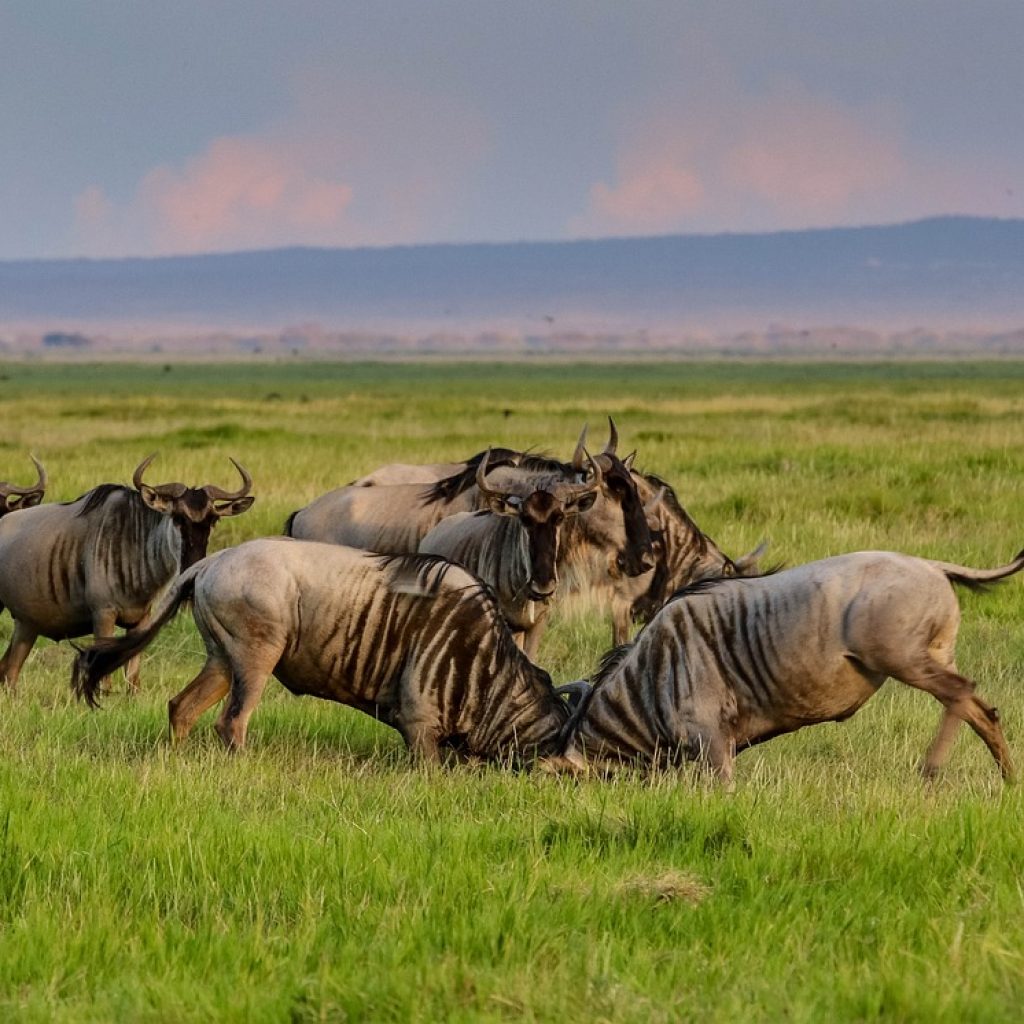
- 8 Days Mid-Range Wildlife Family Safari in Kenya
- Amboseli / Maasai Mara
- 8 Days , 7 Nights
The 8-day tour takes you through prime national parks and game reserves.....
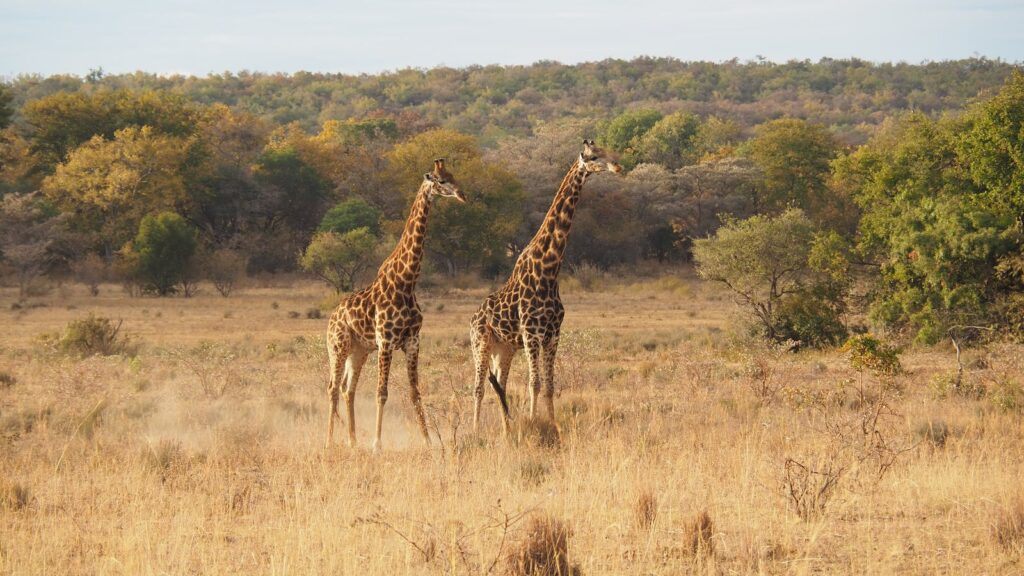
- 5-Day Kenya Wildlife Family Safari
- Masai Mara / Nakuru
- 5 Days 4 Nights
This is a safari that will allow you to explore the famous.....

- 6 Day Maasai Mara, Lake Nakuru & Amboseli Family Safari
- Maasai mara / Lake Nakuru / Amboseli
- 6 Days 5 Nights
Book a spectacular 6-day Kenya tour packed with an exciting overview of.....
The Big 5 Safari Packages

- Mombasa/Diani to Maasai Mara 3 days fly in safari
- Maasai Mara
- 3 Days,2 Nights
Embark on an exhilarating three-day Fly-In Safari from Mombasa/Diani to the world-renowned.....

- 3 Days Amboseli Fly-in Safari
- Amboseli National Park
Embark on a captivating three-day Amboseli Fly-In Safari for a swift and.....
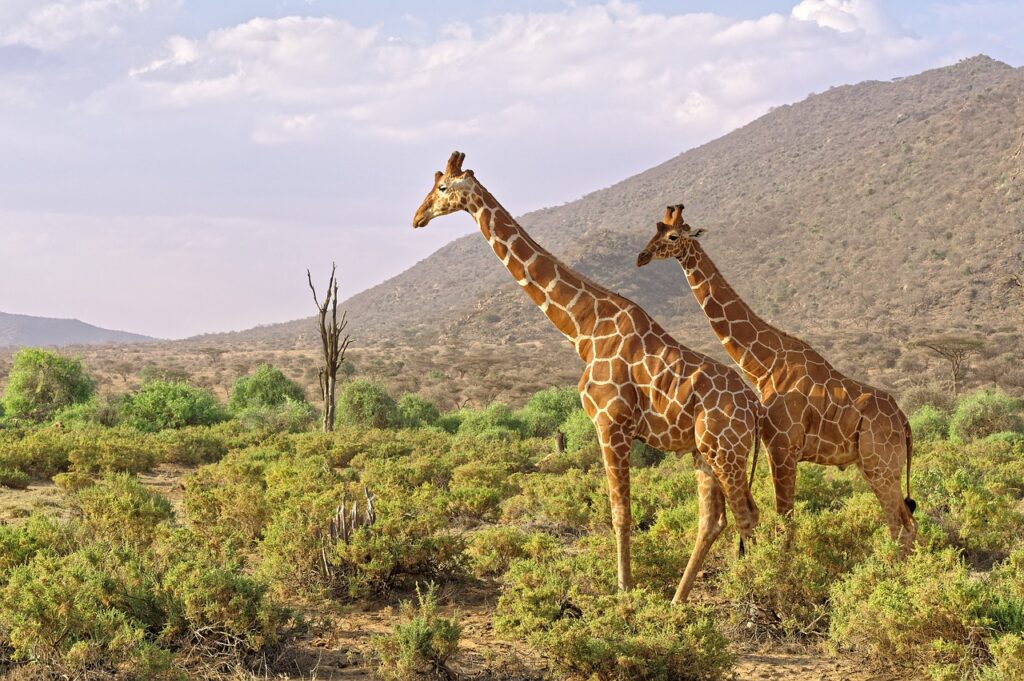
- 3 Days Samburu National Reserve Fly-in Safari
- Samburu National Reserve
- 3 Days, 2 Nights
Embark on a captivating three-day Samburu Fly-In Safari for a swift and.....
Top Destinations
- Tours & Safaris
- Tanzania (10)
Excursions & Day Trips
Explore the wonders of Mombasa with Trek Afrika Adventures! Our experienced guides lead exciting excursions and day trips in the region, showcasing the city’s beauty and culture. Discover Fort Jesus, Old Town, and the Haller Park Nature Trail. Unwind on pristine beaches like Diani. Additionally, we now offer Nairobi excursions for an enriching experience of Kenya’s capital city.
Why Choose Us
Expertise and local knowledge.
Benefit from our deep local insights; our seasoned guides unveil hidden treasures, ensuring your authentic, enriching travel experience.
Customized Itineraries
Indulge in personalized travel with tailor-made itineraries, crafted to match your unique preferences and interests, ensuring a memorable journey.
Exceptional Customer Service
Enjoy worry-free travel with our dedicated support from inquiry to journey's end, making your trip seamless and memorable, just a call or email away.
Sustainability and Responsible Travel
Embark on eco-conscious adventures & Tours, contributing to preservation and growth in the destinations we visit, while minimizing environmental impact.
Latest Tours and Adventures Articles
Tours and Adventures Blog: Your gateway to exciting travel stories, insider tips, and inspiration for unforgettable journeys around the world.
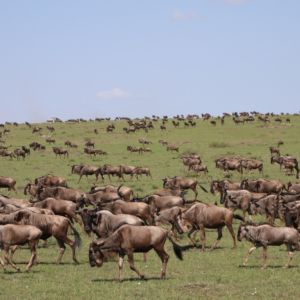
A 10-Day Safari Itinerary in Kenya.
A 10-Day Safari Itinerary in Kenya. A 10-day safari itinerary in Kenya is not just a journey; it’s a profound
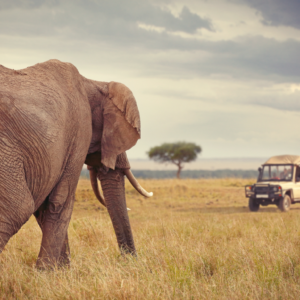
How to Plan Your First Safari to Kenya in 2024
Plan Your First Safari to Kenya in 2024 Kenya, often referred to as the “Safari Capital of the World,” is
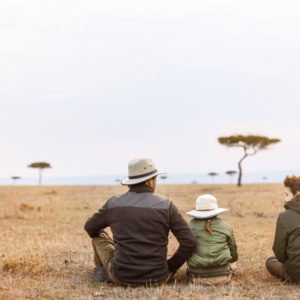
Exploring the Magic of Kenya with Kids in 2024
Exploring the Magic of Kenya with Kids in 2024 Envision your family surrounded by the mesmerizing landscapes of Kenya, with
What Our Happy Clients say about us
Our clients love working with us, just read what they have to say!
I had the most incredible experience with Trek Afrika Adventures! From the moment I booked my safari, the team took care of every detail. Our guide, David, was not only knowledgeable about the wildlife but also passionate about conservation. The accommodations were top-notch, providing both comfort and an authentic African experience. I can't wait to plan my next adventure with Trek Afrika Adventures.

As a travel blogger, I've been fortunate to explore many destinations. However, my journey with Trek Afrika Adventures stands out. The carefully crafted itinerary allowed me to capture breathtaking shots of wildlife and landscapes that will elevate my blog to a new level. The guides' expertise in positioning us for the perfect shot was impressive. I'm grateful for this experience and can't recommend them enough.

Trek Afrika Adventures provides not just a vacation, but an educational journey through Africa's diverse ecosystems. I joined their educational tour with a group of students, and it was a transformative experience. The guides seamlessly blended adventure with learning, making every moment exciting and informative. Our young explorers left with a profound appreciation for nature. Kudos to the Trek Afrika team for fostering a love for the environment!

In the midst of a demanding professional life, I decided to embark on a much-needed escape with Trek Afrika Adventures. The decision was absolutely worth it. The company's commitment to luxury and adventure was evident throughout the journey. Every aspect, from the accommodations to the activities, was tailored to provide relaxation and rejuvenation. The stress of work faded away against the backdrop of Africa's stunning landscapes.

+254 725 925339
Email for us, [email protected].
- Terms and Conditions
- Privacy Policy
TOUR CATEGORY
- Adventure Safaris
- Bush & Beach Safaris
- Cross Border Safaris
- Cultural Safaris
- Family Safaris
- Kenya Big Five Safaris
- Romantic Holidays
SECURE PAYMENT

Copyright 2024 © Trek Adventures. Design and developed by Wayne graphics Solutions
Best Hikes in South America
Best Hikes in Southeast Asia
World's Best Long-Distance Hikes
Hiking Boots, Shoes, and Sandals: How to Choose
Buying and Breaking in Hiking Boots
Hiking Boots
Lightweight Hiking Shoes
Men's Hiking Boots
Men's Hiking Sandals
Waterproof Hiking Boots
Women's Hiking Boots
Women's Hiking Sandals
List of Essential Gear
Hiking Pants
Hiking Shirts
Hiking Socks
Baby Carriers
Hiking Watches
Trekking Poles
A Complete Packing List
Tips for Hiking With Kids
Tips for Hiking With Dogs
Mapping and Navigating Your Route
10 Essential Safety Tips
Tech for Backcountry Communication
Best Hikes in US National Parks
Amazing Mountain Hikes in the US
Best Hiking Trails in Canada
Best Hikes in Europe
Best Hikes in Africa
10 Best Mountain Treks in Africa
:max_bytes(150000):strip_icc():format(webp)/anoukmarrakech-56a373305f9b58b7d0d20299.jpg)
Challenging peaks can be found from Morocco's Atlas Mountains all the way down to South Africa's Drakensberg. Africa's most popular trekking destination is Mount Kilimanjaro , the highest mountain on the continent. Lesser known ranges like Uganda's Rwenzori Mountains offer an incredible array of snow-capped peaks right next to the equator.
Other fantastic hikes in Africa that don't necessarily involve great heights include the Wild Coast (South Africa) and the Fish River Canyon (Namibia).
Mount Kilimanjaro, Tanzania
TripSavvy / Ivey Redding
Mount Kilimanjaro is Africa's most popular trekking destination, and at 19,336 feet it's Africa's highest peak. The trek to the summit takes you through 5 different climatic zones. More than 20,000 people attempt the climb every year.
Routes vary in degree of difficulty, traffic, and scenic beauty. The least difficult routes are Marangu and Rongai; the more difficult routes are Machame, Shira, and Lemosho. The longer routes have more difficult hiking but you'll be more acclimatized and your chances of reaching the summit are therefore higher.
Mount Kenya, Kenya
Mount Kenya is Africa's second highest peak. While the highest peaks Batian (5200m) and Nelion (5188m) require some technical climbing, Lenana (4985m) is the peak trekkers head to. Mount Kenya's slopes are cloaked in forest and moorland which gives way to rock, ice and snow. The mountain is part of a larger reserve .
The best time to climb Mount Kenya is between January - February, and July - October. There are huts on the mountain, or you can camp.
Atlas Mountains, Morocco
TripSavvy / Chris VR
Jebel Toubkal, situated in the High Atlas Mountains is North Africa's highest peak at 4,167m (13,667 ft). It's a challenging trek to the summit, but worth it for the spectacular views. While you can make it to the summit and back to the town of Imlil in a day, it's recommended you take at least 3 days to get the most out of it. Imlil is only about an hour from Marrakech .
. The Atlas Mountains cover a wide territory and there are many good treks available in the Mid, High and Anti Atlas Mountains. All offer a chance to meet with Berber people.
Companies that organize treks to the High Atlas Mountains include:
- Lawrence of Morocco
- Rediscover Morocco
- Naturally Morocco Limited
- Tourdust Adventure Travel
Simien Mountains, Ethiopia
The Simien Mountains are a vast mountain range in Ethiopia with many summits above 4,000 meters (13,000 feet). The highest peak is Ras Dashen which stands at 4,543 meters (14,901 feet), making it the fourth highest mountain in Africa.
Trekking here is fantastic, not only because of the scenery, gorges, and streams, but also because you get a chance to see some unique, endemic wildlife like the gelada baboon and Walia Ibex.
Most treks start from Debark (or Debarek), which is a 3-4 hours drive from Gondar. Equipment, porters, donkeys and more can be arranged from here.
The Drakensberg, South Africa
The Drakensberg is South Africa's highest mountain range, called uKhahlamba in Zulu meaning "barrier of spears". Its lower elevations are perfect for day hikes , horse riding, San Rock Art viewing and bird watching. Its higher passes offer more challenging treks.
Serious hikers should look into the "Drakensberg Traverse," a 2-3 week hike that encompasses many of the Drakensberg's giant peaks, and dramatic pinnacles, including the Tugela Falls which drop over 3000 feet and tumble over 5 separate tiers. If you don't have that much time, try the spectacular trek from the Sentinel to the Cathedral .
Mount Meru, Tanzania
Mount Meru is Tanzania's second highest mountain standing at 4,566 metres (14,980 ft). It is often used a practice acclimatization run for its close neighbor, Mount Kilimanjaro. The trek up to the summit of this rather beautiful volcano takes 3-4 days. The route passes through ancient lush rain forests of fig trees, giving way to heather and rocky moors. Along the the trail, buffaloes, baboons and giraffes are commonly sighted as well as hundreds of species of birds.
The best time to go up is August - October. Hikers spend the nights in small well-tended huts along the route. An armed ranger is compulsory so it's best to organize your trip in advance.
Rwenzori Mountains, Uganda
The Rwenzori Mountains (Mountains of the Moon) lie just north of the Equator along the border of the Democratic Republic of Congo ( DRC ) and Uganda . Mount Stanley is the highest mountain in the range, with twin summits each standing over 5,000m high making it Africa's 3rd tallest mountain. Permanent glaciers adorn the peaks.
The main trail up Mount Stanley's peaks is called the Central Circuit and takes 4-10 days. Along the route, you'll encounter thick forest, bogs, boulders, glaciers and elephants. Guides and armed rangers are compulsory. There are basic huts along the routes. Best time to trek is December - February and June - August.
Mount Elgon, Uganda and Kenya
Mount Elgon is a huge extinct volcano that straddles the border between Kenya and Uganda. There are 5 major peaks, the two highest are Wagagai (4,321m) in Uganda and Sudek (4,302m) in Kenya. The caldera is one of the largest in the world. The routes offer challenging hikes along gorges, waterfalls, and caves.
December - March is the best time to hike. You must hire an official guide. In Uganda, check in at Mbale for equipment, information and trekking permits.
There are several routes to choose from, if you're planning to reach the summit of any of the highest peaks, you'll want to spend at least 5 days on the mountain.
Mount Cameroon, Cameroon
Mount Cameroon locally known as Mongo ma Ndemi ("Mountain of Greatness") is West Africa's highest peak, standing at 4,040 meters (13,255 ft). Mount Cameroon is an active volcano, the last eruption took place in 2000.
There are several trails on the mountain. The oldest and steepest trail is the Guinness Trail named after an annual marathon race that used to be sponsored by Guinness Beer .
Porters and guides are compulsory on this 2-3 day trek. Basic huts and camps can be found on the main trails. The main route passes through farmland, rainforest, montane forests, savanna and, finally, reaches the rocky summit.
Mulanje Mountain, Malawi
Mulanje Mountain is a huge granite massif in southern Malawi . Its highest peak Sapitwa reaches just over 3000m. There are plenty of routes to choose from with simple huts at the end of each one. This is a wonderful hike for families, with lots of streams and peaks to explore. You should spend at least 2 nights on the mountain.
The Mountain Club of Malawi has good route information as well as information on fees and how to pay your porters. If you join the Mountain Club you can use their cooking facilities stored in the huts. Start your hike from the Lihkubula Forest Lodge .The best time to climb Mulanje is between May and October.
The Complete Guide to Climbing Morocco's Mount Toubkal
The Top 15 Things to See and Do in Morocco
10 of the Best Places to Visit in Morocco
Africa Highlights: What to Do and Where to Go
The Best Countries in the World for Adventurous Travelers
10 Unforgettable Activities to Top Your Africa Bucket List
Top Tips for Climbing Mount Meru in Tanzania
Simien Mountains National Park: The Complete Guide
How to Climb Mount Kilimanjaro: The Complete Guide
Top 10 Destinations in Africa for a First-Time Visitor
The Complete Guide to the Atlas Mountains
10 Destinations to Top Your Africa Bucket List
Top 10 Destinations in North Africa
13 Amazing Trips to Take Before You Turn 40
What I Learned From Climbing Mount Kilimanjaro
2020 Travel Warnings for Countries in Africa
trek , verb
Visualise quotations, browse related words, by category.
"Trek, v." Dictionary of South African English. Dictionary Unit for South African English, 2023. Web. 28 April 2024.
Dictionary of South African English , s.v. "trek, v." accessed April 28, 2024, https://dsae.co.za/entry/trek/e07310 .
Trek, v. (2023). In Dictionary of South African English. Retrieved from https://dsae.co.za/entry/trek/e07310
This entry documents historical language usage which may be offensive or disturbing.
Create an account
Start your adventure today.
Already a member? Login

10 Spectacular Multi-Day Hikes in Africa: Explore the Preserved Wilderness
Quick navigation.
Mount Kilimanjaro
- Mount Mulanje
Mount Toubkal
Fish River Canyon
- Otter Trail
- Amatola Trail
- Outeniqua Trail
Mount Meru Trek
Naukluft Hiking Trail
The Drakensberg Grand Traverse
- Travel Insurance
Best Treks and Backpacking Trails
Join our newsletter.
Get a weekly dose of discounts and inspiration for adventure lovers
Explore Africa’s wild and rugged wilderness by foot on one of these formidable multi-day hikes. Africa is the world’s second-largest continent, but it is indisputably the best trekking destination in the world! Comprised of plateaus, mountains, ridges, and basins, Africa is abundant with an unrivaled diversity of flora and fauna that characterize the wild character of the land. Explore equatorial forests, savanna grasslands, highlands, tropical deserts, idyllic lakes, rapid waterways, and much, much more.

The topographic range and variety of wildlife provide unmatched hiking conditions. From the Great Escarpment in South Africa, the Atlas Mountains of Morocco, Namibia’s Fish River Canyon, and Tanzania’s famed Mount Kilimanjaro, below you will find a variety of amazing adventures that will beckon you to set out exploring. In no particular order, we have compiled a list of the 10 greatest treks on the continent in the hopes that one of these routes will inspire you to book your next holiday!

1. Mount Kilimanjaro
This famed mountain trek is at the top of many bucket lists. Mount Kilimanjaro is the highest peak on the continent, and the climb up into the clouds is not without its challenges. This incredible hike passes through 5 climate zones to the snow-capped volcanic summit, including forests, moorlands, and alpine deserts. Ironically, half the hassle of Mount Kilimanjaro is deciding which of the 7 routes to take up to the summit.
While the terrain is not especially technical, the consistent climb and elevation gain is laborious. That being said, considerable planning is required, including conditioning and altitude training. Check out our preparation guide for trekking Mount Kilimanjaro for an exhaustive training and planning checklist. Note that it is not possible to hike without a guide, so it is recommended to book a Kilimanjaro tour , which includes knowledgeable local guides, camping equipment, and more.
Location: Tanzania Distance: Distances vary depending on the route you chose, check out our guide to trekking Mount Kilimanjaro for detailed trail info. Days Recommended: 5-10 days When to do: January-March

2. Mount Mulanje
Mulanje’s peak is the highest in Malawi, beckoning trekkers and intrepid rock climbers to explore its slopes. Frequently shrouded in fog, the isolated massif has 20 peaks, the highest of which being Sapitwa, which has earned the title as the “island in the sky”. While the mountain looks rocky and rugged from a distance, your trek up to the summit travels past tumbling waterfalls, through lush grasslands, green plateaus, wooded ravines, and boulder fields.
Although there are several day-hikes around the base of the mountain, the most immersive and life-changing experience is a multi-day hike into the clouds. The mist-cloaked mountain has 10 mountain huts and over 18 route options to choose from that are managed by the Mountain Club of Malawi. Though guides are not required, it is wise to book a tour as the vast network of trails can easily make you disoriented. Tour guides and accommodations, maps, and more can be booked on-site at a trailhead or reserved through the Mountain Club of Malawi website .
Location: Malawi Distance: Distance vary depending on the chosen route Days Recommended: 1-4 days When to do: April-November

Mulanje massif by Mickaël T. , CC-BY 2.0
3. Mount Toubkal
Located in the heart of Morocco’s Atlas Mountain Range, Mount Toubkal stands tall at 4,167 m above sea level. A magnet for adventure enthusiasts, the Toubkal Trek is quite esteemed and requires only a 2–3-day commitment, making it great for adventurers on a tight schedule. While not overly technical, the climb demands some stamina and significant elevation gain (including sleeping at high elevations), so conditioning and altitude training are recommended.
Explore rocky valleys and mountain pastures, interact with Berbers in remote villages, and indulge in a traditional cup of mint tea as you climb into the Atlas Mountains. While this is a hot trekking destination, the hospitality and rugged wilderness remains unspoiled. Although this climb can be completed without a guide, booking a tour is wise to avoid getting lost and to ensure a bed in the mountain refuges. Over on the 10Adventures website, you will find an array of Atlas Mountains Tours that will surely quench your thirst for adventure, including the Mount Toubkal Trek .
Location: Morocco Distance: Approx. 37.0 km Days Recommended: 1-3 days When to do: May-October

4. Fish River Canyon
Explore the second largest canyon in the world along the Fish River Canyon Hike. This 85km trek explores the rugged river canyon in Namibia, progressing through billions of years of geological history. Wander along the meandering river past pinnacles and sculptures, sulfur hot springs, and through rock fields. Surprisingly, the Fish River Canyon is abundant with wildlife, including antelope, snakes, scorpions, hyrax, mountain zebras, and more!
This arduous trek requires some athleticism and significant preparation. Hikers will have to carry all their equipment and food as there are no en-route facilities. Additionally, while water is plentiful along the trail, hikers require water tablets or a purifier. Although the trek itself is demanding, it is perhaps more of a challenge to secure a hiking permit and campsite reservations through the Namibia Wildlife Resorts . As there is no shade, this trek is only accessible from May-September due to extreme heat.
Location: Namibia Distance: 85.0 km Days Recommended: 4-6 days When to do: May-September

5. Otter Trail
The Otter Trail is the most popular trekking route in South Africa. Located on the Garden Route, this one-way trail stretches 42.0 km from Tsitsikamma to Nature’s Valley over the rugged coastal headlands, through lush forests, along pristine beaches, and past tumbling waterfalls. Showcasing the natural beauty of the coastal region, hikers will also enjoy the opportunity to navigate tidal river crossings, which can only be attempted during low tide.
This spectacular route is well-loved; thus, the Garden Route National Park has implemented a reservation system to safeguard the environment from overuse. Because of this, hikers must obtain an Otter Trail reservation at least a year in advance. Accommodations along this amazing trail include comfortable huts at each overnight stop along the route. This is undoubtedly one of the most beautiful hikes on the continent, so add it to the bucket list!
Find wonderful trekking tours in South Africa on 10Adventures.
Location: South Africa Distance: 42.0 km Days Recommended: 3-5days When to do: Year-round

Ranná túra v Tsitsikamma. by Peter Chovanec , CC-BY 2.0
6. Amatola Trail
The Amatola Trail is another glorious trekking route in South Africa, though this hike is remarkably more challenging than the above-mentioned Otter Trail. Exhibiting the other-worldly beauty of the continent’s southern region, this trek travels 100.0 km from Maden Dam near King Williams Town to the village of Hogsback. Explore the fantastic Amatola Mountains, indigenous forests such as the Malan Forest, grassy plateaus, deep gorges, cascading falls and so much more.
Earning the title of one of the toughest hikes in South Africa, those hoping to explore the Amatola Trail are required to do some conditioning and training before heading out. This undulating trail will test you both physically and mentally, but the exceptional scenery and feeling of accomplishment at the trail’s end are unrivaled! While the terrain is primitive and technical, hikers will indulge in the luxury of sleeping in shelters along this hut-to-hut trek. Note: a hiking permit is required and can be secured online through the Amatola Trails website .
There are so many incredible adventure to urs in South Africa to choose from, see if you can find your next adventure now
Location: South Africa Distance: 100.0 km Days Recommended: 4-6 days When to do: Year-round

Amatola Hiking Trail by Alfred Payne , CC BY-SA 2.0
7. Outeniqua Trail
The Outeniqua Trail is another amazing hut-to-hut thru-hike in South Africa. This hidden gem on the Garden Route stretches over 100.0 km through the National Park’s Knysna section from Beervlei to Harkerville. This diverse adventure traverses a swathe of wilderness that is occupied by wild waterways, the Outeniqua Mountain foothills, indigenous forests, shrublands, and eucalyptus plantations.
Compared to other routes in South Africa, such as the Amatola Trail, this adventure is more accessible and even novice trekkers with a decent fitness level should be able to manage the route. Along the way, hikers lay their heads to rest in backcountry huts that line the trail. Accommodations are reserved via email at [email protected] and the additional conservation fee required to hike can be paid in advance or upon arrival. No matter the season, you should come prepared to brave rainy conditions, the Outeniqua Mountains enjoy the maritime weather conditions.
Location: South Africa Distance: 110.0 km Days Recommended: 5-6 days When to do: Year-round

George seen from Outeniqua Pass by Bernard DUPONT , CC BY-SA 2.0
8. Mount Meru Trek
Hike up to the summit of Tanzania’s second-highest peak and the fifth-highest mountain in Africa on the Mount Meru Trek. The Momella Route is the only official trail up to the peak, traveling 45.0 km through the Arusha National Park’s rugged and wild wilderness. This arduous ascent explores the lush montane forests, volcanic craters, and alpine deserts abundant with an array of wildlife that includes warthogs, giraffes, monkeys, buffaloes, leopards, elephants, and a diversity of bird species!
Due to the area’s surplus of fauna, a game ranger must accompany trekkers and their guides. Note: this route is a popular warmup for the famed Mount Kilimanjaro Trek, which sits 70.0 km east of Mount Meru, so expect some company. Additionally, the mountain huts that line this route book fast, so reserve your accommodations ASAP or book through a tour company. We here at 10Adventures have an epic Mount Meru trek that includes accommodations, a professional guide, park fees, food, and more—check it out.
Check out all the trekking tours in Tanzania and book a vacation that will create memories that will last a lifetime.
Location: Tanzania Distance: 45.0 km Days Recommended: 3-4 days When to do: January-March

9. Naukluft Hiking Trail
The Naukluft Hiking Trail is a dynamic and demanding trek that circles the perimeter of the Naukluft Nature reserve. Considered to be one of the toughest trails on the continent, this route undulates through the Naukluft Mountains, descends into steep gorges via chains anchored into the rock faces, and visits the occasional waterfall or swimming hole. Immerse yourself in an arid ecosystem abundant with zebras, klipspringers, leopards, gemsbok, baboons, snakes, and more.
Hikers will also have to be self-sufficient and will need to arrange for a resupply box to be delivered on day 4 of the trek. Considerable preparation and proper gear are required when attempting this feat, including a sturdy pair of footwear—refer to our guide to picking out the best hiking boots for some helpful tips and tricks. Those who wish to tackle this taxing trek must present a medical record attesting to their fitness competencies. While this journey is incredibly challenging, it is highly rewarding.
Location: Namibia Distance: 120.0 km Days Recommended: 6-8 days When to do: March-October

10. The Drakensberg Grand Traverse
The Drakensberg Grand Traverse is the quintessential South African hiking experience. From the Sentinel Car Park to Bushmans Nek Border Post, this trek travels roughly 220.0 km from South Africa, into Lesotho, and back into South Africa. Showcasing the majesty of the landscape, this long-distance trail summits several peaks in the eastern portion of the Great Escarpment, including Mont Aux Sources, Cleft Peak, Champagne Castle, Giant’s Castle, and the Thabana Ntlenyana.
This scenic route climbs above the clouds and travels along the crests of the mist-shrouded Drakensberg Mountains, passing through the shrubbery, rock fields, river crossings, and past magical waterfalls. While the terrain is not overly technical, the significant elevation gain is burdensome. Don’t forget your camping gear, the huts along this route are limited and camping is the most popular accommodation option. Note: the necessary permit for this trek can be purchased at the Sentinel Car Park.

Location: South Africa Distance: 220.0 km Days Recommended: 8-12 days When to do: Year-round
Vacations in Africa
A trip to Africa is on almost every adventurer’s bucket list. If you are thinking about an incredible African adventure, check out the possibilities, such as Cycling Tours in Africa , or browse the complete portfolio of tours in Africa . But be warned, once you’ve had a taste of Africa you may find yourself coming back year after year, exploring this exciting continent.
Check out our series of articles on the best treks and backpacking trails on earth!
- 10 Best Treks in Asia
- 10 Best Treks in Australia
- 10 Best Treks in Canada
- 10 Best Treks in Europe
- 10 Best Treks in New Zealand
- 10 Best Treks in the UK
- 10 Best Treks in the US
- 10 Best Backpacking Trails in Canada
- 10 Best Backpacking Trails in the US
- 10 Best Backpacking Trails in Western Canada
- Best Treks in Iceland
- Best Treks in Nepal
Top Destinations
Tour activities, top regions, get travel inspiration and discounts.
Join our weekly travel newsletter
APRIL SALE: Book now and get up to 60% off!
Hiking & Trekking Tours & Trips in Africa
Spot the big five on a safari through South Africa , embark on a gorilla trek in Uganda , or go hiking through the Atlas mountain range . Africa is the ideal destination for a wild adventure!
250+ Hiking & Trekking tour packages in Africa with 2,960 reviews
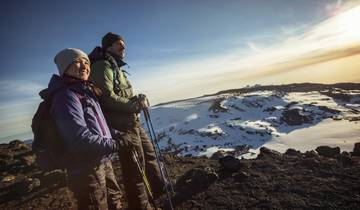
- Hiking & Trekking
- Mountain Hikes
- Christmas & New Year
Mt Kilimanjaro Trek - Lemosho Route
This was the best G Adventures trip I ever took. It was a group of 11 people and came with 38 staff (5 guides/CEOS) and 32 porters/g-fighters. The motivational support of the CEOs was better than I’ve had on any G adventures trip. You can tell all the staff love working for G adventures and it is a company that treats them well. It is a very happy group of people that support you in every way to get you to Uhuru peak. The whole thing is run like a military operation and I have no idea how they manage to cook such great meals at that altitude. It is a very professional operation. Highly highly recommend. AMAZING in every way. Experience of a lifetime because of the fun spirit and support of the local G adventures CEOs and g fighters. My only suggestion for G adventures is: 1) it is very hard to call/email g adventures to get a timely response before your trip. Once you are there the local team is fantastic. 2) the price of the trip without discounts is on the higher end (which I’m ok with as it seems they pay their local teams better than most) but I believe it should include the toilet tents. We ended up renting 2 toilet tents for a group of 11 at $200 per toilet (a porter has to carry and clean each one). This came out to $36/person which was the best $ we could have spent. However, for the price G charges for the trip it seems they should include this feature and advertise it as an included feature. No one on the trip regretted this purchase!!!!!

Mt Kilimanjaro Trek - Machame Route (8 Days)
Your staff where so friendly and helpful. The meals they made where good and tasty, the equipment was good, gerald and his team of G fighters where fantastic really helped and supported everyone throughout the tour safety great and you felt safe in their hands could of made it to the top without these guys! I had a great experience and would definitely use G Adventures again on my next trip x
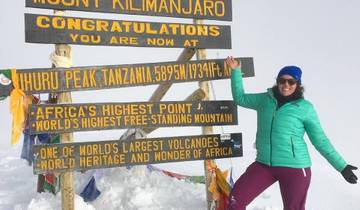
Kilimanjaro climbing machame route 7 days
Amazing experience with very professional staff

Kilimanjaro Climbing Via Lemosho Route 10 Days (all accommodation and transport are included)
Booked an 8 day Lemosho hike up Kilimanjaro with Spider Tours. Communication was quick with Bryan. Pick up from the Arusha airport was waiting for me even though I arrived early. Hotel in Moshi was decent although the restaurant/ cafe called Dawn around the corner from the hotel had much better food. The hike was very well organized and they made sure I had the proper equipment and warm clothing. Spider tours took me to a rental store to obtain some warmer clothing that I did need for the hike. My guide Daniel was excellent and kept a good slow pace to acclimatize to the altitude. I did have 8 days of medicine for the altitude. Some people didn't and did not summit.. Support staff were properly equipped and very friendly. Food was plentiful with lots of tea and warm soup to start every meal. I highly recommend this local company Spider Tours and Safaris. They can change any itinerary to meet your needs and interests. I did finish the hike in 6 days instead of 8 days and Spider Tours did offer other tours to fill the extra days before my flight.
- Book With Flexibility This operator allows you to rebook your dates or tours with them for free, waiving change fees.
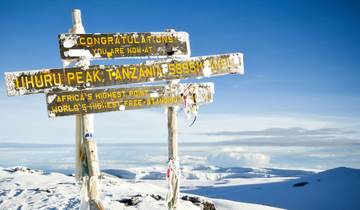
10 Days Mount Kilimanjaro Climbing - Lemosho Route
My girl friend and I did the 10 day Mount Kilimanjaro trek via Lemosho route. The guides were amazing and supported us very well. All the meals were huge with lots of fruit and vegetables. Our chef was great and made sure we had coffee in the tent each morning, lots of food to eat, snacks and tea at the end of the day and helped with out packs when we came in. The route is challenging but through the great crew we had then we made it to the top of the Mount Kilimanjaro. Uhuru peak never forget haha :)
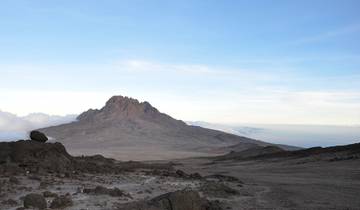
Kilimanjaro: Machame Route
This was an incredibly challenging and rewarding trip. The Intrepid guides were so knowledgeable, friendly and professional. We had a fantastic group with great dynamics, the food was good, the equipment was well looked after, our porters were such hard workers and our guides knew everything there was to know about the mountain and how to best deal with the altitude and looked after us all really well. I highly recommend climbing Kili with Intrepid.

Cape Verde - Santiago, Fogo, São Vicente & Santo Antão Islands 11 Days
It has been such an amazing experience to discover Cape Verde with the wonderful people from BuCountry Tours. I would highly recommend this tour to anybody who really wants to make the most of their trip to these beautiful islands.
- 10% deposit on some dates Some departure dates offer you the chance to book this tour with a lower deposit.

Serengeti & Kilimanjaro (from Nairobi to Kilimanjaro)

Mount Kilimanjaro climbing via Marangu Route 8 days Tanzania (all accommodation and transport are included)
My family and I used spider tours and safaris recently, and couldn't be happier. They always went the extra mile, and had extremely reasonable prices, compared to other companies. Plus, they're a local company, and it seems like they treat their porters well. Highly recommend!
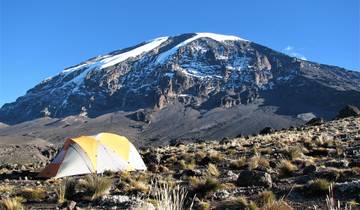
Kilimanjaro climb lemosho route 8 days
The experience was simply incredible & the views from the summit - breathtaking. The team at Almighty Kilimanjaro lead by guides Jackson, Anton, and Assistant Guide, James, were outstanding. Special mentions to crew including waiters Zu & Tom, ToTo for ensuring we had a clean bathroom & toilet tent, And, the chef for his creative cooking - keeping our bellies full of delicious food everyday. Having opted for the 8 day Lemosho route, we were very pleased with our decision come Summit day. We have adjusted to the altitude enough to give everything we had for the summit 'push' - albeit in gruelling conditions. The wind and wind chill on the summit were nothing like we've ever experienced before and whilst we were well prepared in terms of gear, I suggest everyone tackling the summit to prepare for an artic climate. In hindsight, we could have done with some hand and foot warmers (even with two layers of gloves and wool socks was cold!) & a spare buff (for when our primary one froze around our faces). On summit day, we recommend not relying on your bladder for water as my bladder and the rubber tube froze completely. Fortunately, my partner was carrying water bottles (which turned to water slushies, still - better than no water!). Mt. Kilimanjaro was one of the best adventures we've had to date & it was made that much more memorable because of the amazing team at Almightly Kilimanjaro!
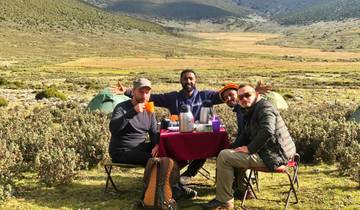

6 Days Bale Mountains Trekking Tour
Excdllent tour. The organisation was, from start to finish, spot on. All the guides etc wee competent, professional and friendly. Camping in the Bale mountains was an unforgetable experience. Totally reccommended

8 Days Mount Kilimanjaro Climbing - Lemosho Route
The entire process of prepping to completing the hike was so easy! The entire team from Steppe Dogs Adventures was Daines! Frank made sure we were fully prepared and knowledgeable before we ever stepped foot on the mountain. Our guide and his team were always there to answer every question we had along the way. Roman our chief guide and assistant guides and every single porter were completely dedicated to successfully getting our group to the summit, making sure to cater to each person's individual needs along the way. The whole crew would sing and route us on when they saw us struggling and really needed that encouragement. We truly couldn't have asked for a better experience, and made great friends with the whole team! They even hooked us up with a home made traditional meal back in town at the end of our trip. Even with the struggles and minor altitude headaches and nausea, we all want to do it again, some day in the future, but try a different route to really get to know the mountain! Strongly recommend these guys!!
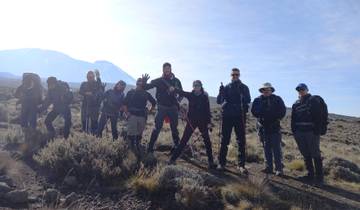
Climb Kili Lemosho Route 7 Day CLIMB, **Qualified Mountain Guides & Sustainability Certification**
We had an absolutely unforgettable trek. Patrick did an amazing job planning out every detail of the trek so meticulously. Our guides were the best, they took care of everything, putting our wellbeing above everything else. They made sure that we reached the top of Kilimanjaro safely. The experience was beautiful from start to finish and we owe it all to Boniface the lead guide and his team, not forgetting Patrick at the office.

Hiking to Ethiopian Highest pick Simien Mountains
A wonderful and extremely memorable trek. we enjoy Simien mountains and the itinerary is well designed. Made fun day bay! the scenery and the many local people that you meet make it all worthwhile. The scenery is amazing and surprisingly varied. Our guide Maru Alemayehu was knowledgeable and helpful. all camping gears were excellent. Simien and it's wildlife are amazing! We found Tankwa tours online using google sear and the team were helpful. I may say special thanks to Mr. Tigistu Tilahun, the one who always on for help!
- 5% deposit on some dates Some departure dates offer you the chance to book this tour with a lower deposit.
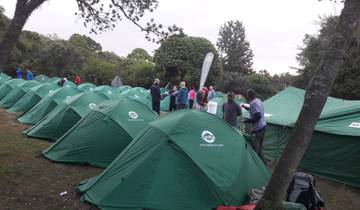
Kilimanjaro Lemosho Route 10 Days *
Remembering the wonderful Kilimanjaro trekking experience on the Lemosho route. We had an amazing crew of two guides, ten porters and one cook supporting the us on the way. I have to give it to Zara tours for being well organized, well equipped and kitted. The successful summit was icing on the cake for a totally wonderful trekking adventure. Asante sana
What people love about Hiking & Trekking Tours in Africa
Excellent tour as expected.
I got Covid from someone in the group. For a high altitude hike like this, we should have been tested for Covid. It not like I could avoid it, we ate together in an enclosed tent.
I cannot say enough good things about this company. From the initial planning to the transfer back to the airport, Almighty Kilimanjaro Travel was amazing. As you plan your trek with them, they are available to answer all questions, incredibly organized and flexible with changes. Everything was on time and exactly as planned.all the rental gear is there, you can leave behind valuables and large bags for no additional charge (they are very meticulous about caring for your valuables, I was not concerned at all). Basically, everything can be accomplished at the hotel, it makes it very seamless and easy. The room are good, breakfast is included and the property is well taken care of. . The service they provided for the trek exceeded expectations. We had 6 guides and 34 porters for 10 of us. The equipment was in good shape and top of the line. The porter's equipment was also good quality. (Some of the budget companies do not take care of their porters). The food they provided was outstanding. Pancakes and eggs for breakfast, soup and chicken or beef dishes with rice, vegetables and fruit for lunch and dinner. Many condiments, peanut butter, jelly, Nutella, etc. Hot tea and even popcorn as an appetizer. They had no problem catering to special diets and that food was amazing as well. We ate in a large tent at one big table with regular chairs, a table cloth, and plates and silverware, very civil. The guides were incredibly knowledgeable and perceptive. They were very proactive about trying to keep us healthy. They watched everyone pretty closely and offered assistance if they saw you starting to struggle. We were briefed everyday on what to expect for the following day. They took the time to answer all questions and always asked for input on our plan. Everyday we are woken up with hot tea brought to the tent, nice touch. Half way though some of the day hikes they would set up a tea and biscuit table in the middle of the trail where we would stop to take a break, that was a nice touch as well. Summit night is incredibly strenuous. These are the guides that you want to assist you. They will carry your pack if need be, motivate you the whole way up and down and basically take care of you any way that they can. Almighty kilimanjaro had four other groups of 30 people that started the same day as us, EVERYONE SUMMITED, all 40 people. That was impressive. We added on a four day safari and that service was top notch as well. The accommodations that they booked for us were really unbelievable, very nice. The vehicle was comfortable with Wi-Fi available and a refrigerator. The guide was knowledgeable and friendly. Couple of recommendations. Rent the private toilet. This is a game changer. Getting up in the middle of the night and having it right there was very convenient and the public ones were usually a hole in the ground, far from the camp. Bring snacks, bars, trail mix, etc. You don't need a thermos, some sites I read say to have one, not necessary. 4 in our group took Diamox, 6 did not, everyone summited, it's a personal choice. On a final note, I wrote an email with a couple of suggestions, and received an immediate response directly from the owner of Almighty Kilimanjaro. Their customer service is bar none! This group really cares about their guests and you will be in the best hands.
Hiking & Trekking Tours
- Mountain Hikes (204)
- Attraction-Based Hikes (29)
- Desert Hikes (22)
- Wildlife Trekking (11)
Travel Styles
- 10 Best Hiking & Trekking Companies
- Your Guide to Planning a Private Hike 2024/2025
- Best Hiking Tours in The World 2024/2025
- Complete Safari Packing List: Clothes, Medicines, Gear & Essentials
- Wildebeest Migration in Africa 2022 (incl. Migration Map)
- 10 Best African Photographic Safaris 2024/2025: Tour Deals & Tips
- 10 Best Self-Drive Safaris 2024/2025
- 10 Best African Wildlife Safari Deals 2024/2025
- Compare Hot Air Balloon Safaris in Africa 2022
- 10 Best African Camping Safari Vacations 2022
- 10 Best Walking Safaris 2024/2025
- 10 Best Beach Safaris: Places & Packages 2022
Phrase is present in reverse dictionary.
trek in English
Translation of "trek" into Afrikaans
Sample translated sentence: Some 3,500 years ago, as the people of Israel trekked across the wilderness of Sinai, they said: “How we remember the fish that we used to eat in Egypt for nothing, the cucumbers and the watermelons and the leeks and the onions and the garlic!” ↔ Sowat 3 500 jaar gelede, terwyl die volk Israel deur die wildernis Sinai getrek het, het hulle gesê: “Ons onthou nog die vis wat ons verniet in Egipte geëet het, die komkommers en die waatlemoene en die preie en die uie en die knoffel!”
A slow or difficult journey. [..]
Automatic translations of " trek " into Afrikaans
"trek" in english - afrikaans dictionary.
Currently we have no translations for trek in the dictionary, maybe you can add one? Make sure to check automatic translation, translation memory or indirect translations.
"Trek" in English - Afrikaans dictionary
Currently we have no translations for Trek in the dictionary, maybe you can add one? Make sure to check automatic translation, translation memory or indirect translations.
reis (@1 : de: Reise )
Reis (@1 : de: Reise )
Images with "trek"
Phrases similar to "trek" with translations into afrikaans.
- Great Trek Groot Trek
Translations of "trek" into Afrikaans in sentences, translation memory

Exploratory treks to Natal
Conflict with the matebele, conflict with the zulu, centenary celebrations, further reading.
The Great Trek led directly to the founding of several autonomous Boer republics , namely the South African Republic (also known simply as the Transvaal ), the Orange Free State , and the Natalia Republic . [5] It also led to conflicts that resulted in the displacement of the Northern Ndebele people , [6] and conflicts with the Zulu people that contributed to the decline and eventual collapse of the Zulu Kingdom . [3]

Before the arrival of Europeans, the Cape of Good Hope area was populated by Khoisan tribes [7] The first Europeans settled in the Cape area under the auspices of the Dutch East India Company (also known by its Dutch initials VOC ), which established a victualling station there in 1652 to provide its outward bound fleets with fresh provisions and a harbour of refuge during the long sea journey from Europe to Asia. [8] In a few short decades, the Cape had become home to a large population of "vrijlieden" , also denoted as "vrijburgers" (free citizens), former Company employees who remained in Dutch territories overseas after completing their contracts. [9] Since the primary purpose of the Cape settlement at the time was to stock provisions for passing Dutch ships, the VOC offered grants of farmland to its employees under the condition they would cultivate grain for the Company warehouses, and released them from their contracts to save on their wages. [8] Vrijburgers were granted tax-exempt status for 12 years and loaned all the necessary seeds and farming implements they requested. [10] They were married Dutch citizens, considered "of good character" by the Company, and had to commit to spending at least 20 years on the African continent. [8] Reflecting the multi-national character of the VOC's workforce, some German soldiers and sailors were also considered for vrijburger status as well, [8] and in 1688 the Dutch government sponsored the resettlement of over a hundred French Huguenot refugees at the Cape. [11] As a result, by 1691 over a quarter of the colony's European population was not ethnically Dutch. [12] Nevertheless, there was a degree of cultural assimilation through intermarriage, and the almost universal adoption of the Dutch language. [13] Cleavages were likelier to occur along social and economic lines; broadly speaking, the Cape colonists were delineated into Boers , poor farmers who settled directly on the frontier, and the more affluent, predominantly urbanised Cape Dutch . [14]
Following the Flanders Campaign and the Batavian Revolution in Amsterdam , France assisted in the establishment of a pro-French client state, the Batavian Republic , on Dutch soil. [2] This opened the Cape to French warships. [3] To protect her own prosperous maritime shipping routes, Great Britain occupied the fledgling colony by force until 1803. [2] From 1806 to 1814, the Cape was governed as a British military dependency, whose sole importance to the Royal Navy was its strategic relation to Indian maritime traffic. [2] The British formally assumed permanent administrative control around 1815, as a result of the Treaty of Paris . [2]
At the onset of the British rule, the Cape Colony encompassed 100,000 square miles (260,000 km 2 ) and was populated by about 26,720 people of European descent, a relative majority of whom were of Dutch origin. [2] [12] Just over a quarter were of German ancestry and about one-sixth were descended from French Huguenots, [12] although most had ceased speaking French since about 1750. [13] There were also 30,000 African and Asian slaves owned by the settlers, and about 17,000 indigenous Khoisan . Relations between the settlers – especially the Boers – and the new administration quickly soured. [5] The British authorities were adamantly opposed to the Boers' ownership of slaves and what was perceived as their unduly harsh treatment of the indigenous peoples. [5]
The British government insisted that the Cape finance its own affairs through self-taxation, an approach which was alien to both the Boers and the Dutch merchants in Cape Town. [3] In 1815, the controversial arrest of a white farmer for allegedly assaulting one of his servants resulted in the abortive Slachter's Nek Rebellion . The British retaliated by hanging at least five Boers for insurrection. [2] In 1828, the Cape governor declared that all native inhabitants but slaves were to have the rights of "citizens", in respect of security and property ownership, on parity with the settlers. This had the effect of further alienating the colony's white population. [2] [15] Boer resentment of successive British administrators continued to grow throughout the late 1820s and early 1830s, especially with the official imposition of the English language. [6] This replaced Dutch with English as the language used in the Cape's judicial and political systems, putting the Boers at a disadvantage, as most spoke little or no English. [2] [15]
Britain's alienation of the Boers was particularly amplified by the decision to abolish slavery in all its colonies in 1834. [2] [3] All 35,000 slaves registered with the Cape governor were to be freed and given rights on par with other citizens, although in most cases their masters could retain them as apprentices until 1838. [15] [16] Many Boers, especially those involved with grain and wine production, were dependent on slave labour; for example, 94% of all white farmers in the vicinity of Stellenbosch owned slaves at the time, and the size of their slave holdings correlated greatly to their production output. [16] Compensation was offered by the British government, but payment had to be received in London , and few Boers possessed the funds to make the trip. [3]
Bridling at what they considered an unwarranted intrusion into their way of life, some in the Boer community considered selling their farms and venturing deep into South Africa's unmapped interior to preempt further disputes and live completely independent from British rule. [3] Others, especially trekboers , a class of Boers who pursued semi-nomadic pastoral activities, were frustrated by the apparent unwillingness or inability of the British government to extend the borders of the Cape Colony eastward and provide them with access to more prime pasture and economic opportunities. They resolved to trek beyond the colony's borders on their own. [6]
Although it did nothing to impede the Great Trek, Great Britain viewed the movement with pronounced trepidation. [14] The British government initially suggested that conflict in the far interior of Southern Africa between the migrating Boers and the Bantu peoples they encountered would require an expensive military intervention. [14] However, authorities at the Cape also judged that the human and material cost of pursuing the settlers and attempting to re-impose an unpopular system of governance on those who had deliberately spurned it was not worth the immediate risk. [14] Some officials were concerned for the tribes the Boers were certain to encounter, and whether these tribes would be enslaved or otherwise reduced to a state of penury . [17]
The Great Trek was not universally popular among the settlers either. Around 12,000 of them took part in the migration, about a fifth of the colony's Dutch-speaking white population at the time. [3] [1] The Dutch Reformed Church , to which most of the Boers belonged, explicitly refused to endorse the Great Trek. [3] Despite their hostility towards the British, there were Boers who chose to remain in the Cape of their own accord. [5]
For its part, the distinct Cape Dutch community had accepted British rule; many of its members even considered themselves loyal British subjects with a special affection for English culture. [18] The Cape Dutch were also much more heavily urbanised and therefore less likely to be susceptible to the same rural grievances and considerations as those held by the Boers. [14]
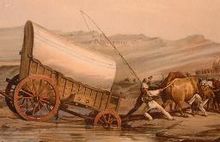
In January 1832, Andrew Smith (an Englishman) and William Berg (a Boer farmer) scouted Natal as a potential colony. On their return to the Cape, Smith waxed very enthusiastic, and the impact of discussions Berg had with the Boers proved crucial. Berg portrayed Natal as a land of exceptional farming quality, well watered, and nearly devoid of inhabitants.
In June 1834, the Boer leaders of Uitenhage and Grahamstown discussed a Kommissietrek ('Commission Trek') to visit Natal and to assess its potential as a new homeland for the Cape Boers who were disenchanted with British rule at the Cape. Petrus Lafras Uys was chosen as trek leader. In early August 1834, Jan Gerritze Bantjes set off with some travellers headed for Grahamstown 220 kilometres (140 mi) away, a three-week journey from Graaff-Reinet . Sometime around late August 1834 Jan Bantjes arrived in Grahamstown, contacted Uys and made his introductions.
In June 1834 at Graaff-Reinet, Jan Gerritze Bantjes heard about the exploratory trek to Port Natal and, encouraged by his father Bernard Louis Bantjes, sent word to Uys of his interest in participating. Bantjes wanted to help re-establish Dutch independence over the Boers and to get away from British law at the Cape. Bantjes was already well known in the area as an educated young man fluent both in spoken and written Dutch and in English. Because of these skills, Uys invited Bantjes to join him. Bantjes's writing skills would prove invaluable in recording events as the journey unfolded.
On 8 September 1834, the Kommissietrek of 40 men and one woman, as well as a retinue of coloured servants, set off from Grahamstown for Natal with 14 wagons. Moving through the Eastern Cape , they were welcomed by the Xhosa who were in dispute with the neighbouring Zulu King Dingane ka Senzangakhona , and they passed unharmed into Natal. They travelled more or less the same route that Smith and Berg had taken two years earlier.
The trek avoided the coastal route, keeping to the flatter inland terrain. The Kommissietrek approached Port Natal from East Griqualand and Ixopo , crossing the upper regions of the Mtamvuna and Umkomazi rivers. Travel was slow due to the rugged terrain, and since it was the summer, the rainy season had swollen many of the rivers to their maximum. Progress required days of scouting to locate the most suitable tracks to negotiate. Eventually, after weeks of extraordinary toil, the small party arrived at Port Natal, crossing the Congela River and weaving their way through the coastal forest into the bay area. They had travelled a distance of about 650 kilometres (400 mi) from Grahamstown. This trip would have taken about 5 to 6 months with their slow moving wagons. The Drakensberg route via Kerkenberg into Natal had not yet been discovered.
They arrived at the sweltering hot bay of Port Natal in February 1835, exhausted after their long journey. There, the trek was soon welcomed with open arms by the few British hunters and ivory traders there such as James Collis, including Reverend Allen Francis Gardiner , an ex-commander of the Royal Navy ship Clinker , who had decided to start a mission station there. After congenial exchanges between the Boers and British sides, the party joined them and invited Dick King to become their guide.
The Boers set up their laager ('wagon fort') camp in the area of the present-day Greyville Racecourse in Durban , chosen because it had suitable grazing for the oxen and horses and was far from the foraging hippos in the bay. Several small streams running off the Berea ridge provided fresh water. Alexander Biggar was also at the bay as a professional elephant-hunter and provided the trekkers with information regarding conditions at Port Natal. Bantjes made notes suggested by Uys, which later formed the basis of his more comprehensive report on the positive aspects of Natal. Bantjes also made rough maps of the bay - although this journal is now missing - showing the potential for a harbour which could supply the Boers in their new homeland.
At Port Natal, Uys sent Dick King, who could speak Zulu, to uMgungundlovu to investigate with King Dingane the possibility of granting them land. When Dick King returned to Port Natal some weeks later, he reported that King Dingane insisted they visit him in person. Johannes Uys , brother of Piet Uys, and a number of comrades with a few wagons travelled toward King Dingane's capital at uMgungundlovu, and after making a laager camp at the mouth of the Mvoti River , they proceeded on horseback, but were halted by a flooded Tugela River and forced to return to the laager .
The Kommissietrek left Port Natal for Grahamstown with a stash of ivory in early June 1835, following more or less the same route back to the Cape, and arrived at Grahamstown in October 1835. On Piet Uys's recommendation, Bantjes set to work on the first draft of the Natalialand Report. Meetings and talks took place in the main church to much approval, and the first sparks of Trek Fever began to take hold. From all the information accumulated at Port Natal, Bantjes drew up the final report on "Natalia or Natal Land" that acted as the catalyst which inspired the Boers at the Cape to set in motion the Great Trek.
The first wave of Voortrekkers lasted from 1835 to 1840, during which an estimated 6,000 people (roughly 20% of the Cape Colony's total population or 10% of the white population in the 1830s) trekked. [17]

The first two parties of Voortrekkers left in September 1835, led by Louis Tregardt and Hans van Rensburg . These two parties crossed the Vaal river at Robert's Drift in January 1836, but in April 1836 the two parties split up, just 110 kilometres (70 mi) from the Zoutpansberg mountains, following differences between Tregardt and van Rensburg. [19]
A party led by Hendrik Potgieter trekked out of the Tarka area in either late 1835 or early 1836, and in September 1836 a party led by Gerrit Maritz began their trek from Graaff-Reinet. There was no clear consensus amongst the trekkers on where they were going to settle, but they all had the goal of settling near an outlet to the sea. [17] : 162, 163
In late July 1836 van Rensburg's entire party of 49, except two children who were saved by a Zulu warrior, were massacred at Inhambane by an impi (a force of warriors) of Manukosi . [20] Those of Tregardt's party that had set up around Soutpansberg moved on to colonise Delagoa Bay , with most of the party, including Tregardt, perishing from fever. [17] : 163
In August 1836, despite pre-existing peace agreements with local black leaders, a Ndebele (Matebele) patrol attacked the Liebenberg family part of Potgieter's party, killing six men, two women and six children. It is thought that their primary aim was to plunder the Voortrekkers' cattle. On 20 October 1836, Potgieter's party was attacked by an army of 4,600 Ndebele warriors at the Battle of Vegkop . Thirty-five armed trekkers repulsed the Ndebele assault on their laager with the loss of two men and almost all the trekkers' cattle. Potgieter, Uys and Maritz mounted two punitive commando raids. The first resulted in the sacking of the Ndebele colony at Mosega , the death of 400 Ndebele, and the taking of 7,000 cattle. The second commando forced Mzilikazi and his followers to flee to what is now modern day Zimbabwe . [17] : 163
By spring 1837, five to six large Voortrekker colonies had been established between the Vaal and Orange Rivers with a total population of around 2,000 trekkers.
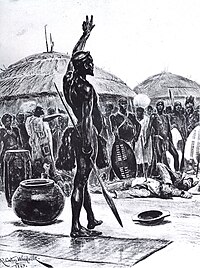
In October 1837 Retief met with Zulu King Dingane to negotiate a treaty for land in what is now Kwa-Zulu Natal . King Dingane, suspicious and untrusting because of previous Voortrekker influxes from across the Drakensberg, had Retief and seventy of his followers killed . [17] : 164
Various interpretations of what transpired exist, as only the missionary Francis Owen 's written eye-witness account survived. [21] Retief's written request for land contained veiled threats by referring to the Voortrekker's defeat of indigenous groups encountered along their journey. The Voortrekker demand for a written contract guaranteeing private property ownership was incompatible with the contemporaneous Zulu oral culture which prescribed that a chief could only temporarily dispense land as it was communally owned. [22]
Most versions agree that the following happened: King Dingane's authority extended over some of the land in which the Boers wanted to settle. As prerequisite to granting the Voortrekker request, he demanded that the Voortrekkers return some cattle stolen by Sekonyela , a rival chief. After the Boers retrieved the cattle, King Dingane invited Retief to his residence at uMgungundlovu to finalise the treaty, having either planned the massacre in advance, or deciding to do so after Retief and his men arrived.
King Dingane's reputed instruction to his warriors, " Bulalani abathakathi! " (Zulu for "kill the wizards") may indicate that he considered the Boers to wield evil supernatural powers. After killing Retief's delegation, a Zulu army of 7,000 impis were sent out and immediately attacked Voortrekker encampments in the Drakensberg foothills at what later was called Blaauwkrans and Weenen , leading to the Weenen massacre in which 532 people were killed, including 282 Voortrekkers, of whom 185 were children, and 250 Khoikhoi and Basuto accompanying them. [23] In contrast to earlier conflicts with the Xhosa on the eastern Cape frontier, the Zulus killed women and children along with men, wiping out half of the Natal contingent of Voortrekkers.
The Voortrekkers retaliated with a 347-strong punitive raid against the Zulu (later known as the Flight Commando), supported by new arrivals from the Orange Free State . The Voortrekkers were roundly defeated by about 7,000 warriors at Ithaleni , southwest of uMgungundlovu. The well-known reluctance of Afrikaner leaders to submit to one another's leadership, which later hindered sustained success in the Anglo-Boer Wars , was largely to blame.
In November 1838 Andries Pretorius arrived with a commando of 60 armed trekkers and two cannon to assist in the defence. A few days later on 16 December 1838, a force of 468 trekkers, 3 Britons , and 60 black allies fought against 10,000 to 12,000 Zulu impis at the Battle of Blood River . Pretorius's victory over the Zulu army led to a civil war within the Zulu nation as King Dingane's half-brother, Mpande kaSenzangakhona , aligned with the Voortrekkers to overthrow the king and impose himself. Mpande sent 10,000 impis to assist the trekkers in follow-up expeditions against Dingane. [17] : 164
After the defeat of the Zulu forces and the recovery of the treaty between Dingane and Retief from Retief's body, the Voortrekkers proclaimed the Natalia Republic . [24] After Dingane's death, Mpande was proclaimed king, and the Zulu nation allied with the short-lived Natalia Republic until its annexation by the British Empire in 1843. [17] : 164 [25]
The Voortrekkers' guns offered them a technological advantage over the Zulu's traditional weaponry of short stabbing spears, fighting sticks, and cattle-hide shields. The Boers attributed their victory to a vow they made to God before the battle: if victorious, they and future generations would commemorate the day as a Sabbath . Thereafter, 16 December was celebrated by Boers as a public holiday, first called Dingane's Day, later changed to the Day of the Vow . Post-apartheid , the name was changed to the Day of Reconciliation by the South African government, in order to foster reconciliation between all South Africans. [25]

Conflict amongst the Voortrekkers was a problem because the trek levelled out the pre-existing class hierarchy which had previously enforced discipline, and thus social cohesion broke down. Instead the trek leaders became more reliant on patriarchal family structure and military reputation to maintain control over their parties. This had a large and lasting impact on Afrikaans culture and society. [17] : 163
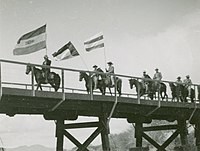
The celebration of the Great Trek in the 1930s played a major role in the growth of Afrikaans nationalism . It is thought that the experiences of the Second Boer War and the following period, between 1906 and 1934, of a lack of public discussion about the war within the Afrikaans community helped set the scene for a large increase in interest in Afrikaans national identity. The celebration of the centenary of the Great Trek along with a new generation of Afrikaners interested in learning about the Afrikaans experiences of the Boer War catalysed a surge of Afrikaans nationalism. [17] : 433
The centenary celebrations began with a re-enactment of the trek beginning on 8 August 1938 with nine ox wagons at the statue of Jan van Riebeeck in Cape Town and ended at the newly completed Voortrekker Monument in Pretoria and attended by over 100,000 people. A second re-enactment trek starting at the same time and place ended at the scene of the Battle of Blood River. [17] : 432

The commemoration sparked mass enthusiasm amongst Afrikaners as the re-enactment trek passed through the small towns and cities of South Africa. Both participants and spectators participated by dressing in Voortrekker clothing, renaming streets, holding ceremonies, erecting monuments, and laying wreaths at the graves of Afrikaner heroes. Cooking meals over an open fire in the same way the Voortrekkers did became fashionable amongst urbanites, giving birth to the South African tradition of braaing . [17] : 432 An Afrikaans language epic called Building a Nation ( Die Bou van 'n Nasie ) was made in 1938 to coincide with the 100th anniversary of the Great Trek. [26] The film tells the Afrikaans version of the history of South Africa from 1652 to 1910 with a focus on the Great Trek. [27]
A number of Afrikaans organisations such as the Afrikaner Broederbond and Afrikaanse Taal en Kultuurvereniging continued to promote the centenary's goals of furthering the Afrikaner cause and entrenching a greater sense of unity and solidarity within the community well into the 20th century. [17] : 432 [28]
Political impact
The Great Trek was used by Afrikaner nationalists as a core symbol of a common Afrikaans history. It was used to promote the idea of an Afrikaans nation and a narrative that promoted the ideals of the National Party . In 1938, celebrations of the centenary of the Battle of Blood River and the Great Trek mobilised behind an Afrikaans nationalist theses. The narrative of Afrikaner nationalism was a significant reason for the National Party's victory in the 1948 elections . A year later the Voortrekker Monument was completed and opened in Pretoria by the newly elected South African Prime Minister and National Party member Daniel Malan in 1949.
A few years later, " Die Stem van Suid-Afrika " ('The Voice of South Africa'), a poem written by Cornelis Jacobus Langenhoven referring to the Great Trek, was chosen to be the words of the pre-1994 South African national anthem. The post-1997 national anthem of South Africa incorporates a section of " Die Stem van Suid-Afrika " but it was decided to omit the section in "reference to the Great Trek (' met die kreun van ossewa '), since this was the experience of only one section of our community". [29] When apartheid in South Africa ended and the country transitioned to majority rule, President F. W. de Klerk invoked the measures as a new Great Trek. [30]
- H. Rider Haggard , Swallow (1899) and Marie (1912)
- Stuart Cloete , Turning Wheels (1937)
- Helga Moray, Untamed (1950) - a 1955 movie of the same name is based on this book.
- James A. Michener , The Covenant (1980)
- Robin Binckes, Canvas under the Sky (2011) ISBN 1920143637 - a controversial novel about a promiscuous drug-using Voortrekker set during the Great Trek. [31]
- Jeanette Ferreira
- F.A. Venter ,
- C. W. H. Van der Post, Piet Uijs, of lijden en strijd der voortrekkers in Natal , novel, 1918.
- Untamed (1955), an adventure/love story set in the later part of the trek about an Irish woman seeking a new life in South Africa after the Great Famine . Based on a 1950 novel of the same name by Helga Moray.
- The Fiercest Heart (1961), an adventure/love story about two British soldiers who desert the military and join a group of Boers heading north on the Great Trek.
- Dorsland Trek
- History of South Africa
Related Research Articles

Boers are the descendants of the proto Afrikaans-speaking Free Burghers of the eastern Cape frontier in Southern Africa during the 17th, 18th, and 19th centuries. From 1652 to 1795, the Dutch East India Company controlled Dutch Cape Colony, but the United Kingdom incorporated it into the British Empire in 1806. The name of the group is derived from Trekboer then later "boer", which means "farmer" in Dutch and Afrikaans.
The Boer republics were independent, self-governing republics formed by Dutch-speaking inhabitants of the Cape Colony and their descendants. The founders – variously named Trekboers, Boers and Voortrekkers – settled mainly in the middle, northern, north-eastern and eastern parts of present-day South Africa. Two of the Boer republics achieved international recognition and complete independence: the South African Republic and the Orange Free State. The republics did not provide for the separation of church and state, initially allowing only the Dutch Reformed Church, and later also other Protestant churches in the Calvinist tradition. The republics came to an end after the Second Boer War of 1899–1902, which resulted in British annexation and later incorporation of their lands into the Union of South Africa.
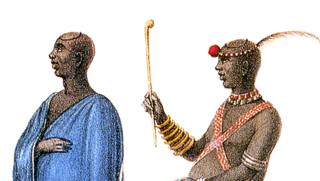
Dingane ka Senzangakhona Zulu , commonly referred to as Dingane or Dingaan , was a Zulu prince who became king of the Zulu Kingdom in 1828, after assassinating his half-brother Shaka Zulu. He set up his royal capital, uMgungundlovu, and one of numerous military encampments, or kraals, in the eMakhosini Valley just south of the White Umfolozi River, on the slope of Lion Hill ( Singonyama ).

Andries Wilhelmus Jacobus Pretorius was a leader of the Boers who was instrumental in the creation of the South African Republic, as well as the earlier but short-lived Natalia Republic, in present-day South Africa. The large city of Pretoria, executive capital of South Africa, is named after him.
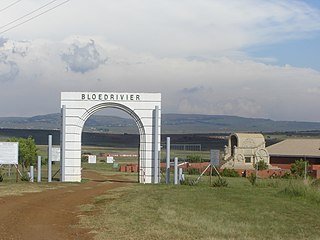
The Battle of Blood River was fought on the bank of the Ncome River, in what is today KwaZulu-Natal, South Africa between 464 Voortrekkers ("Pioneers"), led by Andries Pretorius, and an estimated 25,000 to 30,000 Zulu. Estimations of casualties amounted to over 3,000 of King Dingane's soldiers dead, including two Zulu princes competing with Prince Mpande for the Zulu throne. Three Voortrekker commando members were lightly wounded, including Pretorius.
The year 1838 was the most difficult period for the Voortrekkers from when they left the Cape Colony, till the end of the Great Trek. They faced many difficulties and much bloodshed before they found freedom and a safe homeland in their Republic of Natalia. This was only achieved after defeating the Zulu Kingdom, at the Battle of Blood River, which took place on Sunday 16 December 1838. This battle would not have taken place if the Zulu King had honoured the agreement that he had made with the Voortrekkers to live together peacefully. The Zulu king knew that they outnumbered the Voortrekkers and decided to overthrow them and that led to the Battle of Blood river.

Andries Hendrik Potgieter , known as Hendrik Potgieter was a Voortrekker leader and the last known Champion of the Potgieter family. He served as the first head of state of Potchefstroom from 1840 and 1845 and also as the first head of state of Zoutpansberg from 1845 to 1852.
The Natalia Republic was a short-lived Boer republic founded in 1839 after a Voortrekker victory against the Zulus at the Battle of Blood River. The area was previously named Natália by Portuguese sailors, due to its discovery on Christmas. The republic came to an end in 1843 when British forces annexed it to form the Colony of Natal. After the British annexation of the Natalia Republic, most local Voortrekkers trekked northwest into Transorangia , later known as the Orange Free State, and the South African Republic.

The Weenen massacre was the massacre of Khoikhoi, Basuto and Voortrekkers by the Zulu Kingdom on 17 February 1838. The massacres occurred at Doringkop, Bloukrans River, Moordspruit, Rensburgspruit and other sites around the present day town of Weenen in South Africa's KwaZulu-Natal province.

The Covenant is a historical novel by American author James A. Michener, published in 1980.

Pieter Mauritz Retief was a Voortrekker leader. Settling in 1814 in the frontier region of the Cape Colony, he later assumed command of punitive expeditions during the sixth Xhosa War. He became a spokesperson for the frontier farmers who voiced their discontent, and wrote the Voortrekkers' declaration at their departure from the colony.
Uys is the surname of a family that played a significant role in South African history during the nineteenth century and made distinguished contributions to South African culture, politics and sports during the course of the twentieth.
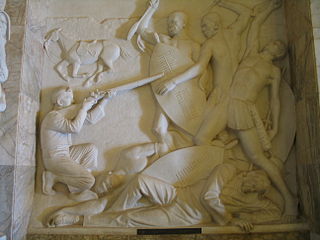
Petrus Lafras Uys (1797–1838) was a Voortrekker leader during the Great Trek.

The Day of the Vow is a religious public holiday in South Africa. It is an important day for Afrikaners, originating from the Battle of Blood River on 16 December 1838, before which about 400 Voortrekkers made a promise to God that if he rescued them out of the hands of the approximately 20,000 Zulu warriors they were facing, they would honour that day as a sabbath day in remembrance of what God did for them.

Richard Philip King (1811–1871) was an English trader and colonist at Port Natal, a British trading station in the region now known as KwaZulu-Natal. He is best known for a historic horseback ride in 1842, where he completed a journey of 960 kilometres (600 mi) in 10 days, to request help for the besieged British garrison at Port Natal. In recognition of his heroic deeds, a statue was unveiled in Durban portraying himself riding his horse 'Sunny’. Additionally, he was bestowed with an estate in Isipingo. Several prominent landmarks in Durban, including the Kings Park Rugby Stadium, Kingsmead Cricket Stadium, the former soccer stadium, and Kingsway High School, were named in his honour.

During the Napoleonic Wars, the Cape Colony was annexed by the British and officially became their colony in 1815. Britain encouraged settlers to the Cape, and in particular, sponsored the 1820 Settlers to farm in the disputed area between the colony and the Xhosa in what is now the Eastern Cape. The changing image of the Cape from Dutch to British excluded the Dutch farmers in the area, the Boers who in the 1820s started their Great Trek to the northern areas of modern South Africa. This period also marked the rise in power of the Zulu under their king Shaka Zulu. Subsequently, several conflicts arose between the British, Boers and Zulus, which led to the Zulu defeat and the ultimate Boer defeat in the Second Anglo-Boer War. However, the Treaty of Vereeniging established the framework of South African limited independence as the Union of South Africa.
The Zulu Kingdom , sometimes referred to as the Zulu Empire or the Kingdom of Zululand , was a monarchy in Southern Africa. During the 1810s, Shaka established a standing army that consolidated rival clans and built a large following which ruled a wide expanse of Southern Africa that extended along the coast of the Indian Ocean from the Tugela River in the south to the Pongola River in the north.

Afrikaners are a Southern African ethnic group descended from predominantly Dutch settlers first arriving at the Cape of Good Hope in 1652. Until 1994, they dominated South Africa's politics as well as the country's commercial agricultural sector.
The Biggar family , Alexander Harvey Biggar and his two sons Robert and George, were pioneer traders at Port Natal, in what was to become the Colony of Natal. Subsequent to the massacre of Retief's delegation, they became involved in the exchange of attacks between Zulus and settlers. Although contributing to the overthrow of Dingane, all three lost their lives in the conflicts of 1838. Alexander's grandson John Dunn became a well-known Natal pioneer in his own right.

The Piet Retief Delegation massacre was the 1838 killing of 100 Voortrekkers by the Zulu king Dingane in what is now KwaZulu-Natal, South Africa. The Voortrekkers, led by Piet Retief, migrated into Natal in 1837 and negotiated a land treaty in February 1838 with Dingane. Upon realizing the ramifications of the imposed contract, Dingane betrayed the Voortrekkers, killing the delegation including Retief on 6 February 1838. The land treaty was later found in Retief's possession. It gave the Voortrekkers the land between the Tugela River and Port St. Johns. This event eventually led to the Battle of Blood River and the eventual defeat of Dingane.
Jan Gerritze Bantjes was a Voortrekker whose exploration of the Natal and subsequent report were the catalyst for mobilising the Great Trek. He was also the author of the treaty between the Zulu king Dingane kaSenzangakhona and the Voortrekkers under Andries Pretorius.
- 1 2 Laband, John (2005). The Transvaal Rebellion: The First Boer War, 1880–1881 . Abingdon: Routledge Books. pp. 10–13. ISBN 978-0582772618 .
- 1 2 3 4 5 6 7 8 9 10 Lloyd, Trevor Owen (1997). The British Empire, 1558–1995 . Oxford: Oxford University Press. pp. 201–206. ISBN 978-0198731337 .
- 1 2 3 4 5 6 7 8 9 Greaves, Adrian (2013). The Tribe that Washed its Spears: The Zulus at War . Barnsley: Pen & Sword Military. pp. 36–55. ISBN 978-1629145136 .
- ↑ Wells, John C. (2008). Longman Pronunciation Dictionary (3rd ed.). Longman. ISBN 978-1-4058-8118-0 .
- 1 2 3 4 Arquilla, John (2011). Insurgents, Raiders, and Bandits: How Masters of Irregular Warfare Have Shaped Our World . Lanham: Rowman & Littlefield Publishing Group. pp. 130–142. ISBN 978-1566638326 .
- 1 2 3 Bradley, John; Bradley, Liz; Vidar, Jon; Fine, Victoria (2011). Cape Town: Winelands & the Garden Route . Madison, Wisconsin: Modern Overland. pp. 13–19. ISBN 978-1609871222 .
- ↑ "The Empty Land Myth" . South African History Online . Retrieved 7 December 2023 .
- 1 2 3 4 Hunt, John (2005). Campbell, Heather-Ann (ed.). Dutch South Africa: Early Settlers at the Cape, 1652–1708 . Philadelphia: University of Pennsylvania Press. pp. 13–35. ISBN 978-1904744955 .
- ↑ Parthesius, Robert (2010). Dutch Ships in Tropical Waters: The Development of the Dutch East India Company (VOC) Shipping Network in Asia 1595–1660 . Amsterdam: Amsterdam University Press. ISBN 978-9053565179 .
- ↑ Lucas, Gavin (2004). An Archaeology of Colonial Identity: Power and Material Culture in the Dwars Valley, South Africa . New York: Springer. pp. 29–33. ISBN 978-0306485381 .
- ↑ Lambert, David (2009). The Protestant International and the Huguenot Migration to Virginia . New York: Peter Land Publishing. pp. 32–34. ISBN 978-1433107597 .
- 1 2 3 Entry: Cape Colony. Encyclopædia Britannica Volume 4 Part 2: Brain to Casting . Encyclopædia Britannica, Inc. 1933. James Louis Garvin, editor.
- 1 2 Mbenga, Bernard; Giliomee, Hermann (2007). New History of South Africa . Cape Town: Tafelberg. pp. 59–60. ISBN 978-0624043591 .
- 1 2 3 4 5 Collins, Robert; Burns, James (2007). A History of Sub-Saharan Africa . Cambridge: Cambridge University Press. pp. 288–293. ISBN 978-1107628519 .
- 1 2 3 Newton, A. P.; Benians, E. A., eds. (1963). The Cambridge History of the British Empire . Vol. 8: South Africa, Rhodesia and the Protectorates. Cambridge: Cambridge University Press. pp. 272, 320–322, 490.
- 1 2 Simons, Mary; James, Wilmot Godfrey (1989). The Angry Divide: Social and Economic History of the Western Cape . Claremont: David Philip. pp. 31–35. ISBN 978-0864861160 .
- 1 2 3 4 5 6 7 8 9 10 11 12 13 14 Giliomee, Hermann (2003). The Afrikaners: Biography of a People . Cape Town: Tafelberg Publishers. p. 161. ISBN 062403884X .
- ↑ Gooch, John (2000). The Boer War: Direction, Experience and Image . Abingdon: Routledge Books. pp. 97–98. ISBN 978-0714651019 .
- ↑ Ransford, Oliver (1972). The Great Trek . London: John Murray. p. 42.
- ↑ "Johannes Jacobus Janse (Lang Hans) van Rensburg, leader of one of the early Voortrekker treks, is born at the Sundays River" . South African History Online. Archived from the original on 19 February 2014 . Retrieved 24 August 2014 .
- ↑ Bulpin, T. V. "9 - The Voortrekkers". Natal and the Zulu Country . T. V. Bulpin Publications.
- ↑ du Toit, André. "(Re)reading the Narratives of Political Violence in South Africa: Indigenous founding myths & frontier violence as discourse" (PDF) . p. 18. Archived from the original (PDF) on 17 December 2008 . Retrieved 18 August 2009 .
- ↑ Johnston, Harry Hamilton (1910). Britain across the seas: Africa; a history and description of the British Empire in Africa . London: National Society's Depository. p. 111.
- ↑ Bulpin, T. V. "11 - The Republic of Natal". Natal and the Zuku Country . T. V. Bulpin Publications.
- 1 2 "Battle of Blood River" . Encyclopædia Britannica . Retrieved 21 May 2010 .
- ↑ Die Bou van 'n Nasie [ Building a Nation ] (in Afrikaans). 1938 . Retrieved 22 March 2024 .
- ↑ "Die Bou van 'n Nasie" (in Afrikaans). IMDb . Retrieved 1 March 2015 .
- ↑ "Great Trek Centenary Celebrations commence" . South African History Online . Retrieved 31 December 2014 .
- ↑ "The national anthem is owned by everyone" . South African Music Rights Organisation . 17 June 2012 . Retrieved 8 January 2015 .
- ↑ Lyman, Rick (22 December 1993). "South Africa approves new constitution to end white rule" . Knight-Ridder Newspapers . Archived from the original on 19 September 2018 – via HighBeam Research.
- ↑ Ritchie, Kevin (11 February 2012). "Mad Boers burn Great Trek bodice ripper" . IOL News . Retrieved 1 March 2015 .
- ↑ Ferreira, Janette (2007). Die Son Kom Aan die Seekant Op (in Afrikaans). Kaapstad: Human & Rousseau.
- Benyon, John. "The necessity for new perspectives in South African history with particular reference to the Great Trek." Historia Archive 33.2 (1988): 1–10. online
- Cloete, Henry. The history of the great Boer trek and the origin of the South African republics (J. Murray, 1899) online .
- Etherington, Norman. "The Great Trek in relation to the Mfecane: a reassessment." South African Historical Journal 25.1 (1991): 3–21.
- Petzold, Jochen. "'Translating' the Great Trek to the twentieth century: re-interpretations of the Afrikaner myth in three South African novels." English in Africa 34.1 (2007): 115–131.
- Routh, C. R. N. "The Great South African Trek." History Today (May 1951) 1#5 pp 7–13 online.
- Von Veh, Karen. "The politics of memory in South African art." de arte 54.1 (2019): 3–24.
- African nationalism
- Afrikaner Calvinism
- Afrikaner nationalism
- Black Consciousness Movement
- Cape Independence
- Day of the Vow
- Greater South Africa
- Honorary whites
- Rooi gevaar
- Swart gevaar
- African National Congress
- Democratic Alliance
- +256705767137
- [email protected]

EXPERIENCE EAST AFRICA YOUR OWN WAY
Where adventure holidays begin, trek africa expeditions offers gorilla & chimpanzees tracking safaris with wildlife adventure tours in east africa.
Start your adventures with Trek Africa Expeditions . Have us worry about the planning, fees payments, accommodation, transportation and transfers, so that you can concentrate on the work of enjoying your trip. From bespoke wildlife guided tours to a relaxing beach holiday in Mombasa, we plan and organize private and group tours that are gentle to your finances yet highly rewarding to your soul. Safari vacations in Africa are just as diverse as the continent itself, though planning an African Safari package can be tasking and expensive, it is also a richly rewarding experience to vacation in Africa . Whether you want to spend a few days gorilla trekking in Uganda or more than two weeks spotting the " Big Five " (Lion, Leopard, African Elephant, Rhino and Cape Buffalo) in the East African savanna, you'll find an array of experiences to best suit your travel excitement. To help you narrow down your options, take a look at these pre-customized safari packages . Note that we can customize any of those trips to suite your style, talk to any of our safari experts to help you get you started.
Safety Travel System
Expert trip planning, budget-friendly tour, fast communication, 24/7 customer support, right solution & guide, suggested east african safari ideas.
Looking for some trip inspiration? Designed by our specialists using their expertise and knowledge, our tailor-made itinerary suggestions below will give you a taste of the type of trips we can put together for you. Bear in mind, these are just a starting point as all holidays are customized to the specific requirements of our guests. Whether you prefer a different style of accommodation, a greater focus on a particular interest or to go to a different destination all together, every itinerary is created individually around your preferences.
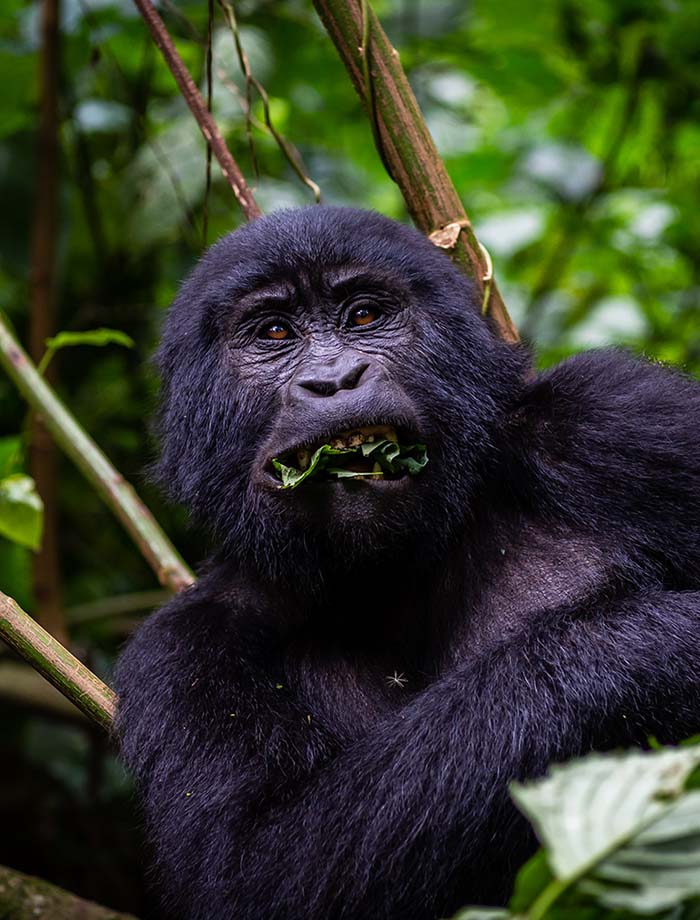
Gorilla Tracking Safari
3 Days/ 2 Nights
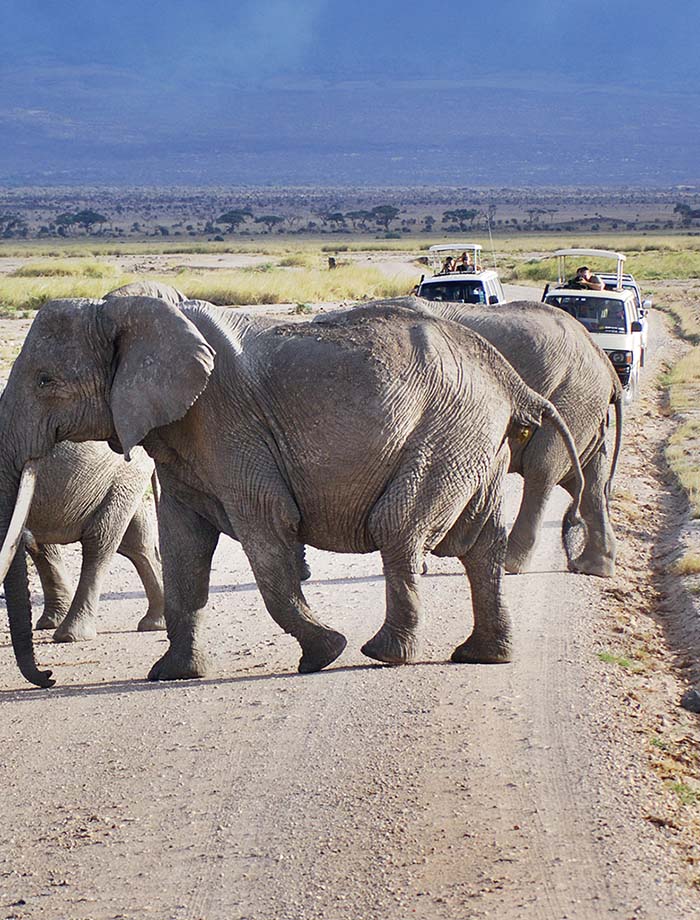
Kenya Camping Safari
6 Days/ 5 Nights
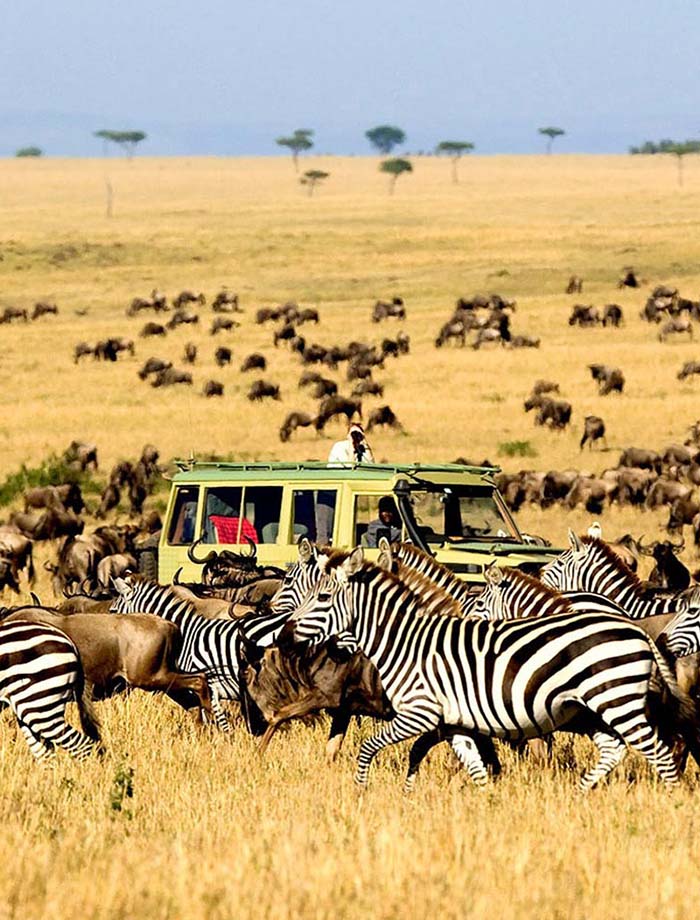
Northern Circuit Safari
Gorilla trekking experience.
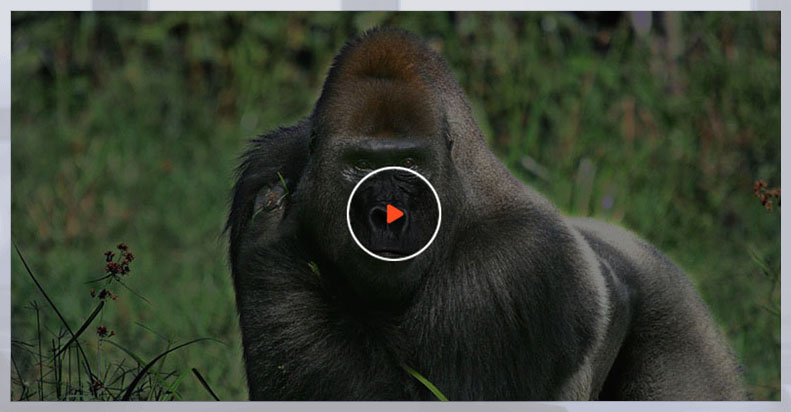
Top notch destinations
If you’re looking for the best safaris to East Africa , then we’ve got a great selection of tours for you to choose from, allowing you to see breath-taking landscapes and a wide variety of wildlife in their natural habitat..
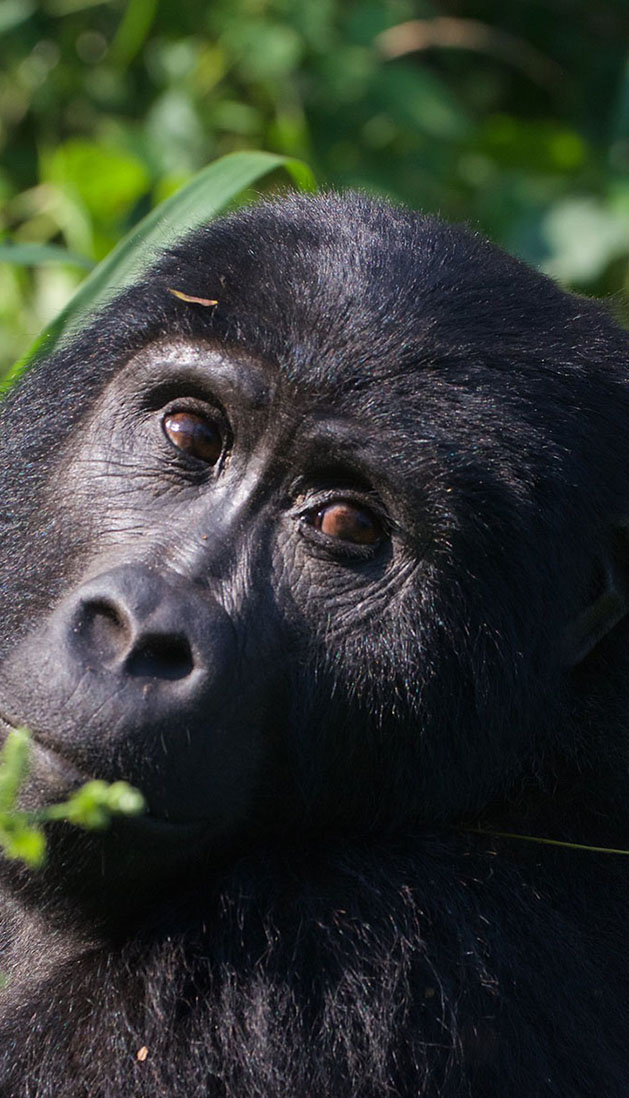
Mt. Gorillas
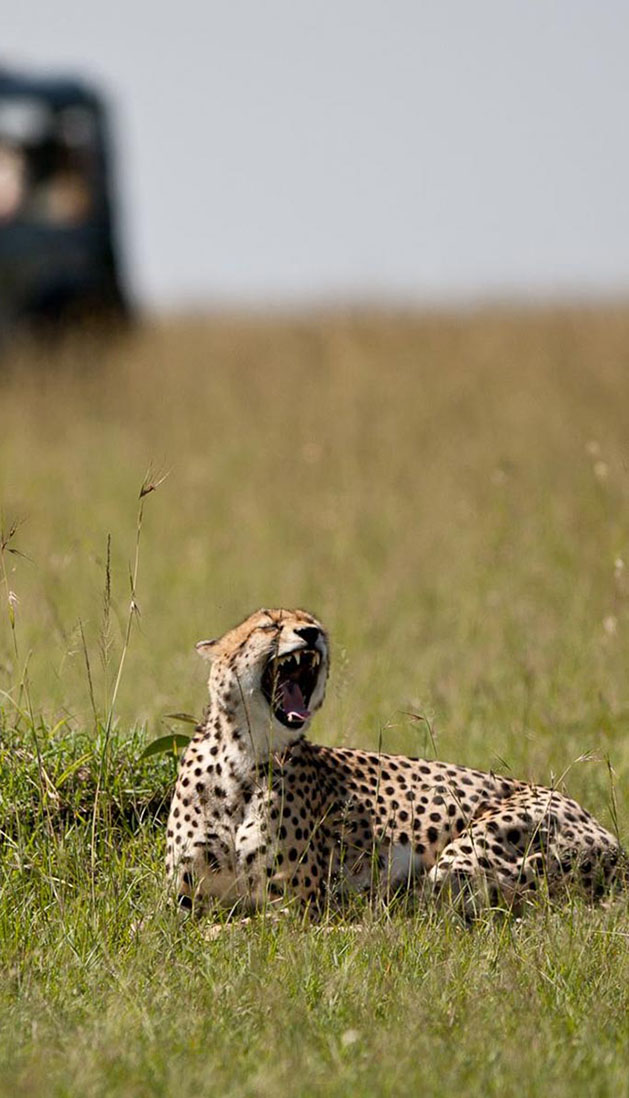
Gorillas & Chimps
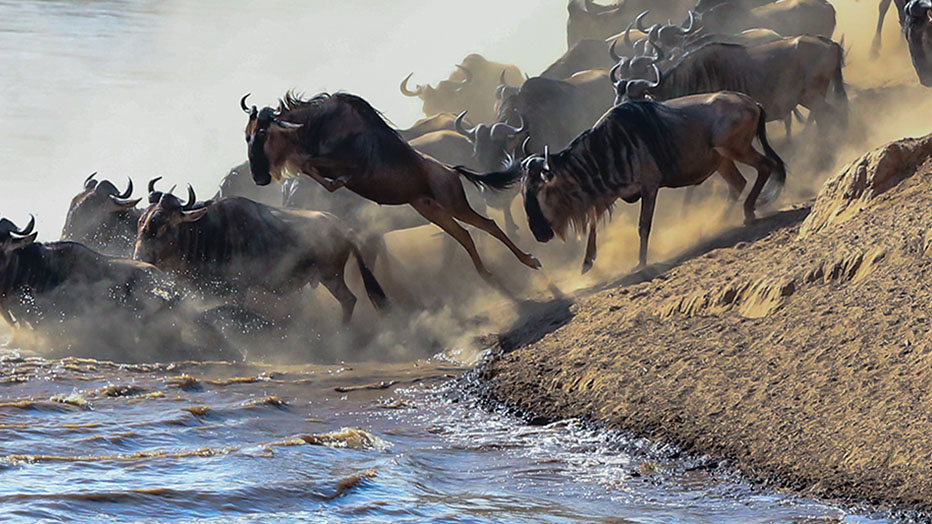
Great Migration
Tailor-made east african safaris.
To help you narrow down your options, take a look at these pre-customized African safari packages . Note that we can customize any of these trips to suite your style, talk to any of our consultants to get you started..
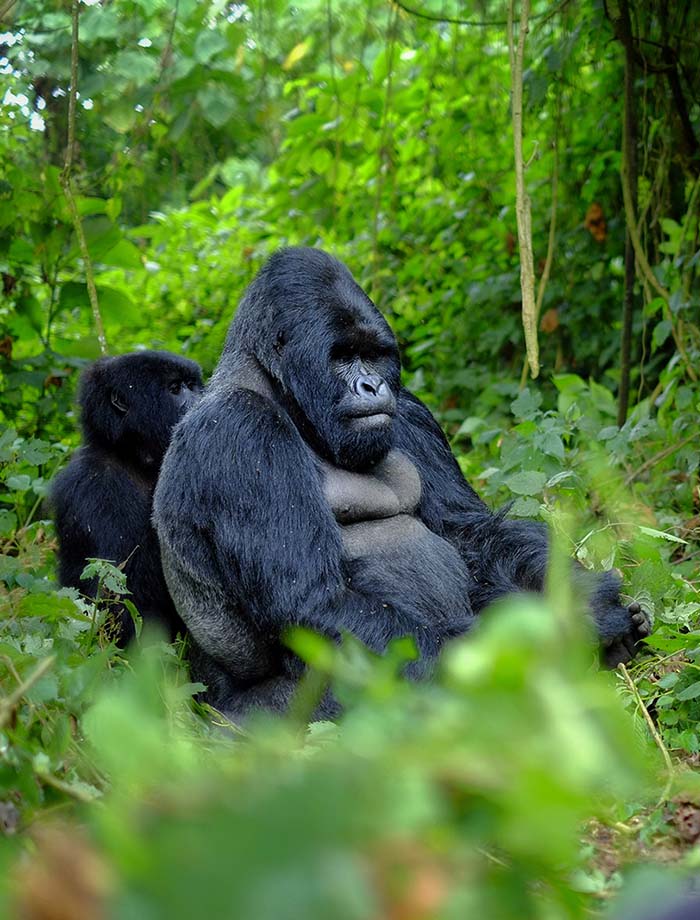
Rwanda Gorilla & Wildlife Safari
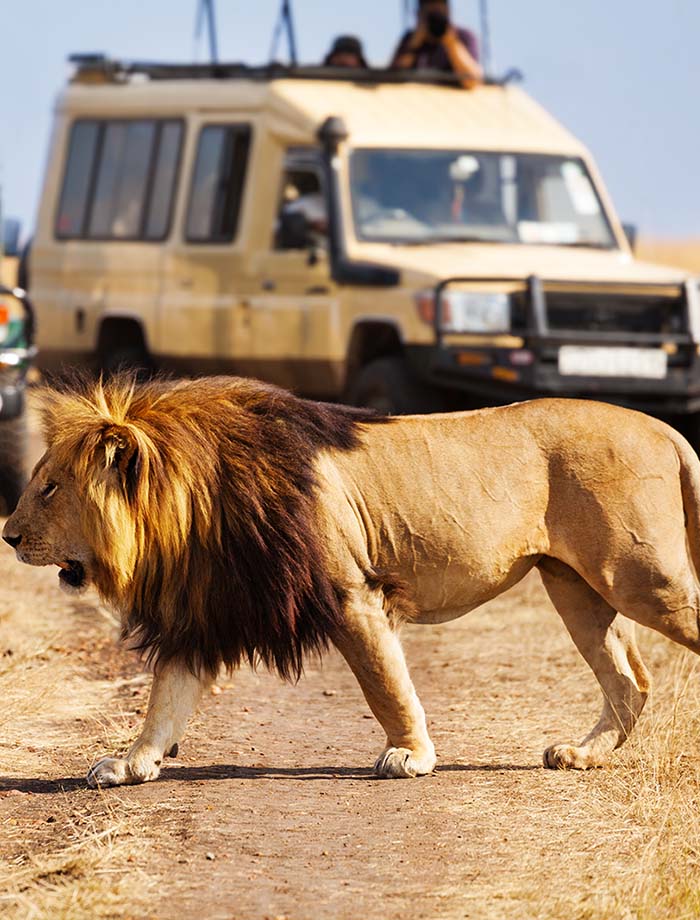
Masai Mara Wildlife Safari
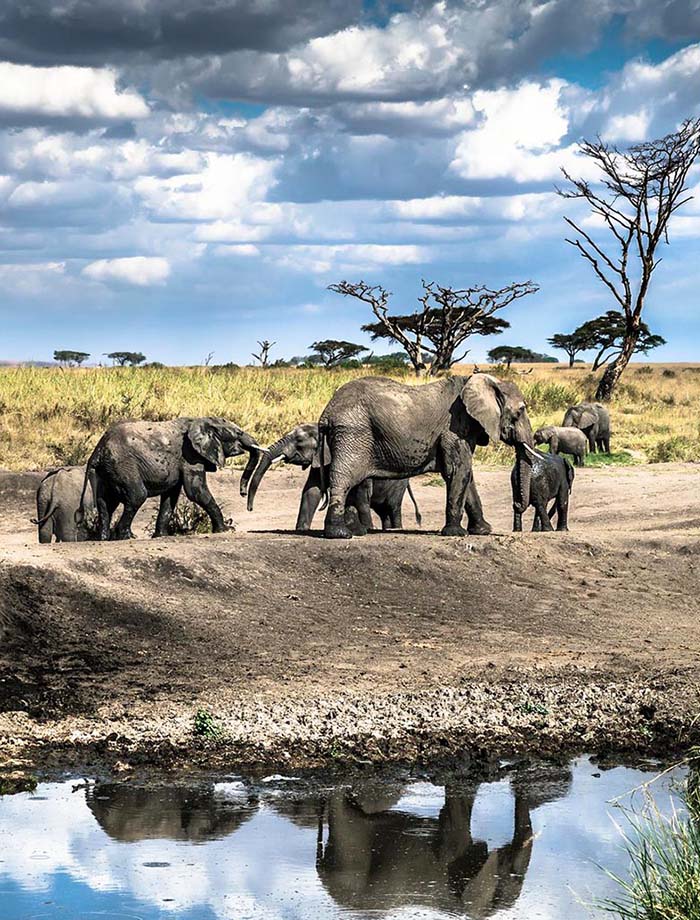
Tanzania Wildlife Safari
Highlights of Rwanda Safari
7 Days/ 6 Nights
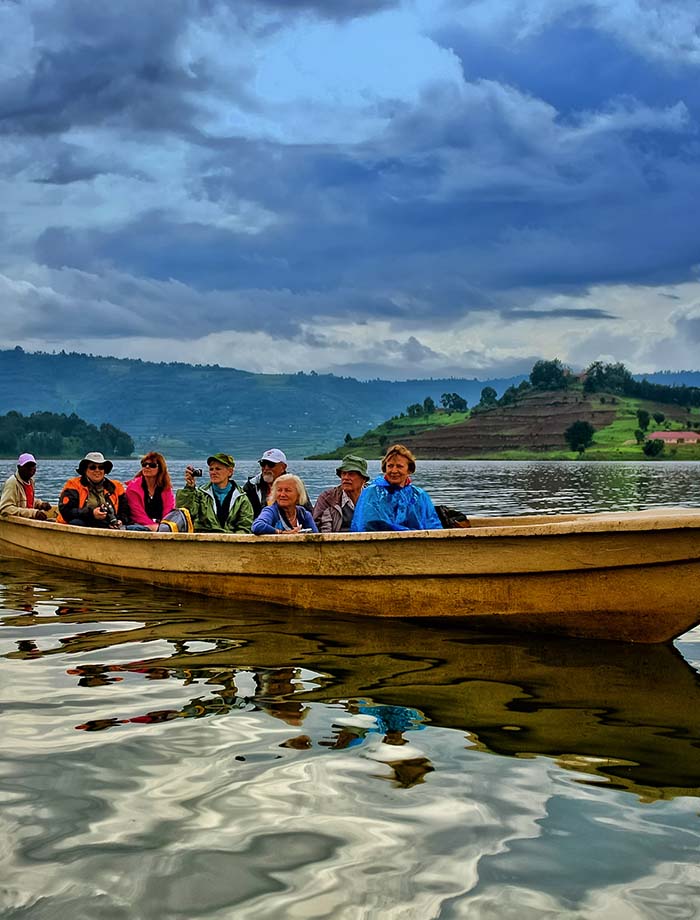
Best of Uganda Safari
12 Days/ 11 Nights
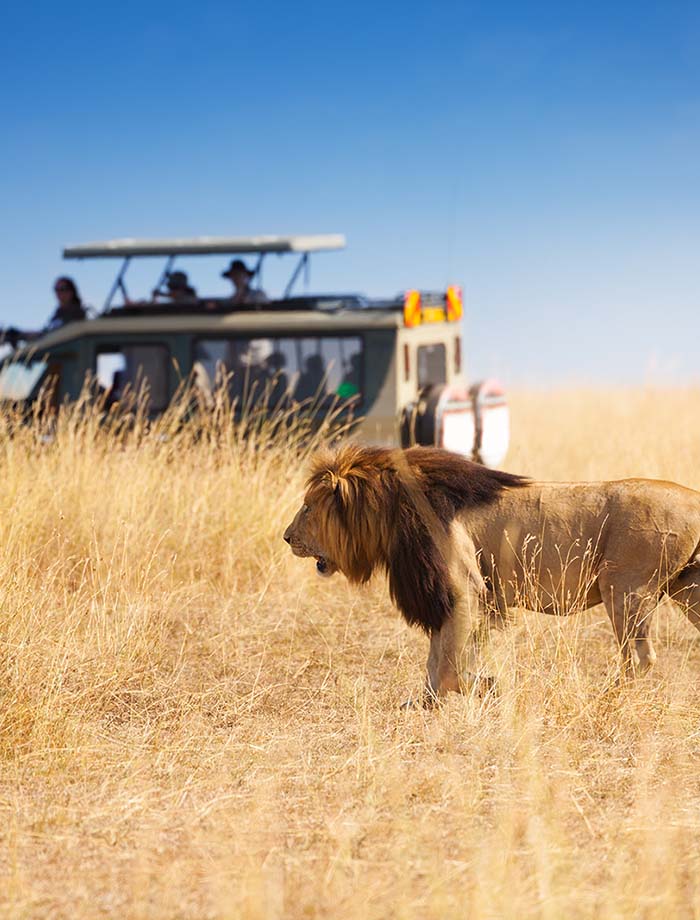
Best of East Africa Safari
14 Days/ 13 Nights
Gorilla Safaris
Gorilla Trekking is an ultimate African adventure that allows you to explore, discover the the few remaining Gorilla Parks in Africa .
Wildlife Adventure Safaris
Sink into carefree, sun-drenched days with Trek Africa Expeditions . From check-in to check-out, indulge your every whim during an all inclusive East African safari holiday where everything is taken care of for you. Dramatic wildlife moments , smiles with new friends, tasty dishes paired with cocktails.
Popular places to visit in East Africa
Featuring heavily on our itinerary ideas for visiting East Africa , these places are destinations that we know prove consistently popular with our travellers. How you choose to include them in your trip can be tailored into a route that best suits your preferences. For Expert Help, Kindly Contact us here
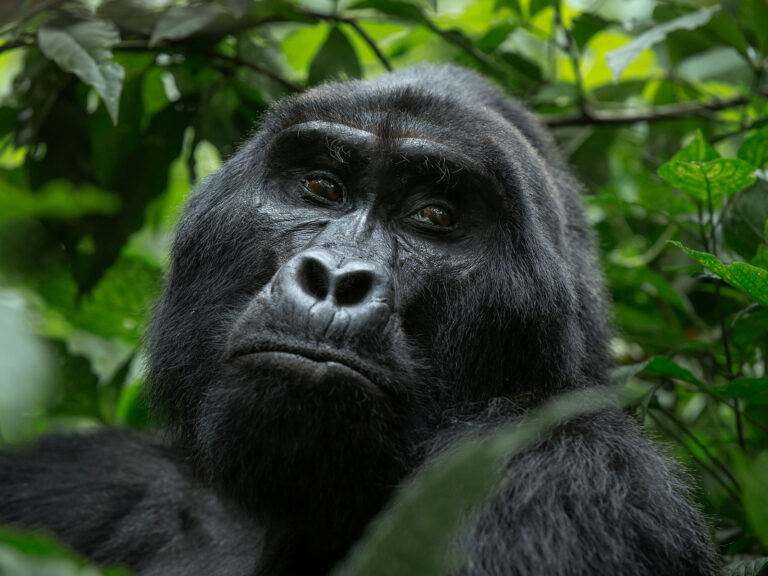
Bwindi Impenetrable National Park
Home to the world's engandered mountain gorillas.
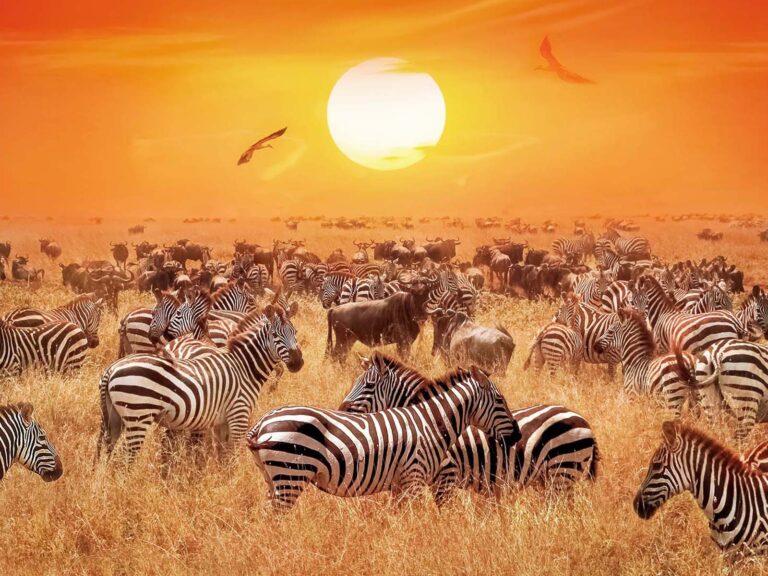
Masai Mara National Reserve
Masai Mara is one of Africa’s most famous parks for game viewing.
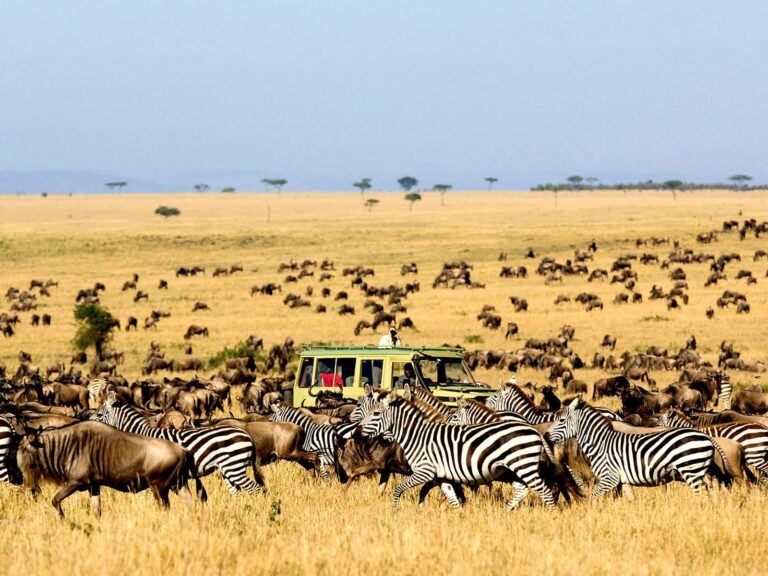
Serengeti National Park
An African gem of wildlife and a place to watch the Greatest wildlife migration.
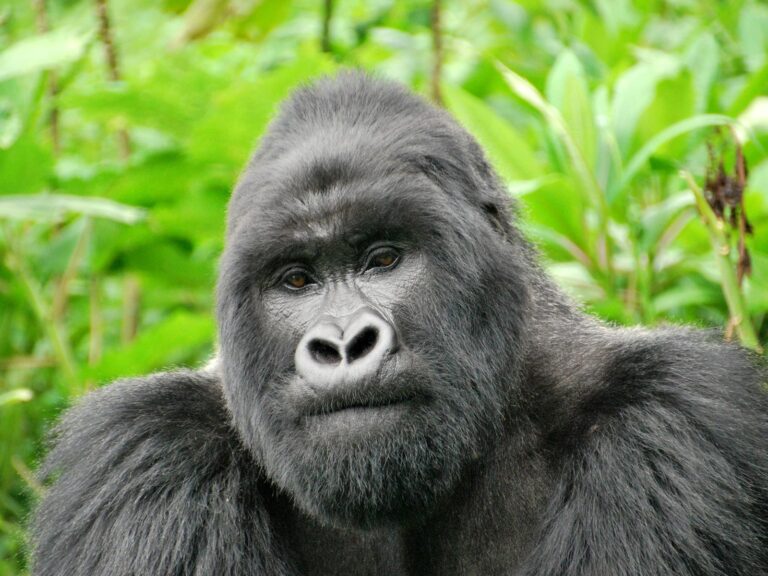
Volcanoes National Park
Habitant to the endangered mountain gorillas and other wildlife spieces.
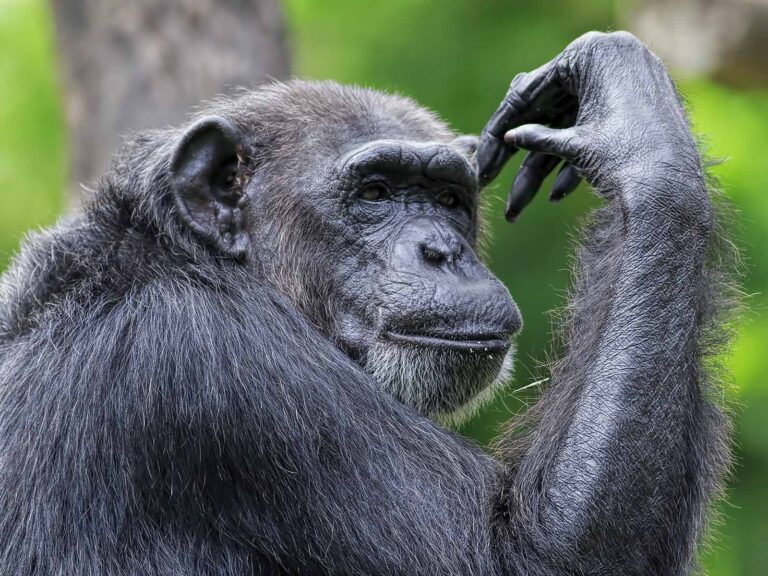
Kibale Forest National Park
Best known as The Primate Capital of The World. it's major attraction are chimpanzees
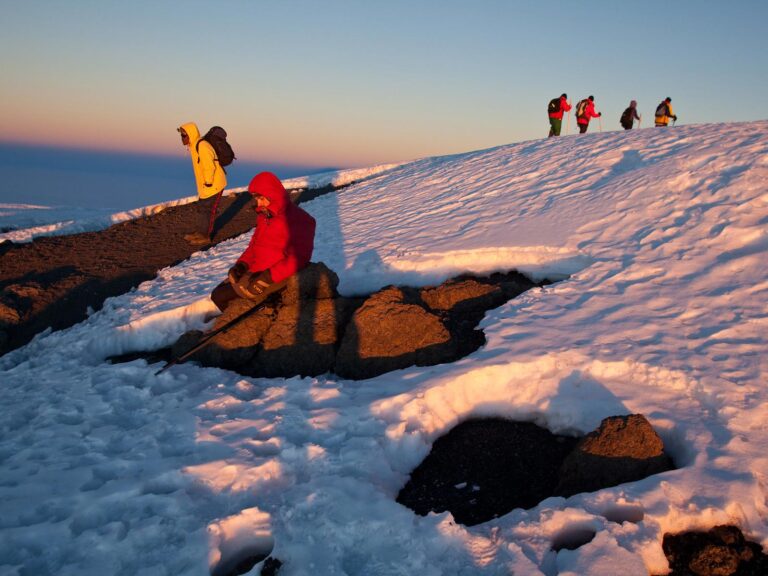
Mt. Kilimanjaro National Park
Mt. Kilimanjaro is the highest point in Africa and tallest stand alone mountain in the world.
Your Trusted African Travel Partner
Planning a Vacation Holiday or an African Safari is not as fun as experiencing the Adventure itself. It can be odious to find the right flights, hotels, local tour operator or Destination Management Company (DMC) to give you the right prices and make sure you are booked into convenient and comfortable facilities that fit your style. There's also making sure the fees and permits are secured in time for your arrival and not forgetting the big elephant in the room—reliability and trust.
Partner with someone that understand what it takes to go on holiday and let's do the worrying for you. You stick to having fun, and we do the rest. Contact our tour consultants/ expert or read more about us
Must-Do Top Safari Activities
To safari is to journey, and Africa is the place. Trek Africa Expeditions offers wildlife viewing that is unimaginable. Get involved in our safari experiences that will tickle your inner feelings to amusement and wildlife excitement, Activities like gorilla and chimpanzee tracking will take you closer to the habituated mountain gorillas and the friendly chimpanzees .
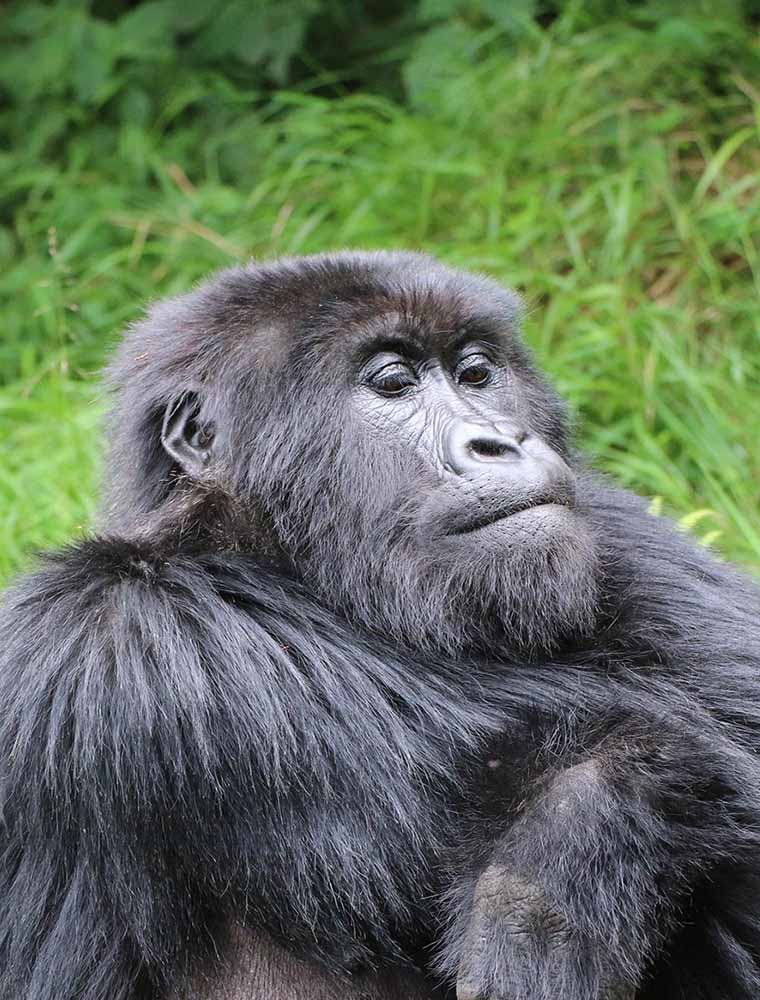
How we plan your African Safari

Request a Quote

Craft a Travel Package

Make a deposit

Pack your bags
Useful tour information.

Responsible Travel in Uganda

Gorilla Permit

Entry Visas for East Africa

FAQs About Gorilla Trekking
Visit our travel notebook >>>
Best Tourist's Shared Photos
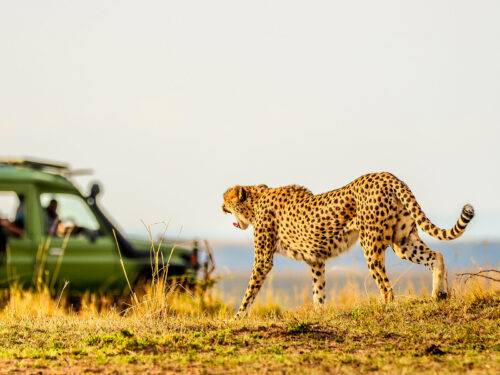
Rubbish (feat. Blood Kid_Dope Boys_Drifta trek) - Single
November 10, 2023 1 Song, 4 minutes ℗ 2024 6907943 Records DK
Select a country or region
Africa, middle east, and india.
- Côte d’Ivoire
- Congo, The Democratic Republic Of The
- Guinea-Bissau
- Niger (English)
- Congo, Republic of
- Saudi Arabia
- Sierra Leone
- South Africa
- Tanzania, United Republic Of
- Turkmenistan
- United Arab Emirates
Asia Pacific
- Indonesia (English)
- Lao People's Democratic Republic
- Malaysia (English)
- Micronesia, Federated States of
- New Zealand
- Papua New Guinea
- Philippines
- Solomon Islands
- Bosnia and Herzegovina
- France (Français)
- Deutschland
- Luxembourg (English)
- Moldova, Republic Of
- North Macedonia
- Portugal (Português)
- Türkiye (English)
- United Kingdom
Latin America and the Caribbean
- Antigua and Barbuda
- Argentina (Español)
- Bolivia (Español)
- Virgin Islands, British
- Cayman Islands
- Chile (Español)
- Colombia (Español)
- Costa Rica (Español)
- República Dominicana
- Ecuador (Español)
- El Salvador (Español)
- Guatemala (Español)
- Honduras (Español)
- Nicaragua (Español)
- Paraguay (Español)
- St. Kitts and Nevis
- Saint Lucia
- St. Vincent and The Grenadines
- Trinidad and Tobago
- Turks and Caicos
- Uruguay (English)
- Venezuela (Español)
The United States and Canada
- Canada (English)
- Canada (Français)
- United States
- Estados Unidos (Español México)
- الولايات المتحدة
- États-Unis (Français France)
- Estados Unidos (Português Brasil)
- 美國 (繁體中文台灣)
Russia Travel Blog | All about Russia in English
- About our blog
- RussiaTrek.org
Sidebar →
- Architecture
- Entertainment
- RussiaTrek.org News

- Send us a tip with a message
- Support RussiaTrek.org
- Travel Guide to Ukraine
- Comments RSS
← Sidebar
The trains and stations of the Moscow Metro
2 Comments · Posted by Alex Smirnov in Cities , Travel , Video
The Moscow Metro is the third most intensive subway system in the world after Tokyo and Seoul subways. The first line was opened on May 15, 1935. Since 1955, the metro has the name of V.I. Lenin.
The system consists of 12 lines with a total length of 305.7 km. Forty four stations are recognized cultural heritage. The largest passenger traffic is in rush hours from 8:00 to 9:00 and from 18:00 to 19:00.
Cellular communication is available on most of the stations of the Moscow Metro. In March 2012, a free Wi-Fi appeared in the Circle Line train. The Moscow Metro is open to passengers from 5:20 to 01:00. The average interval between trains is 2.5 minutes.
The fare is paid by using contactless tickets and contactless smart cards, the passes to the stations are controlled by automatic turnstiles. Ticket offices and ticket vending machines can be found in station vestibules.
Tags: Moscow city
You might also like:

The bridge over Zolotoy Rog Bay in Vladivostok
The views of St. Petersburg from the TV tower >>
Tomás · August 27, 2012 at 11:34 pm
The Moscow metro stations are the best That I know, cars do not.
Alberto Calvo · September 25, 2016 at 8:57 pm
Great videos! Moscow Metro is just spectacular. I actually visited Moscow myself quite recently and wrote a post about my top 7 stations, please check it out and let me know what you think! :)
http://www.arwtravels.com/blog/moscow-metro-top-7-stations-you-cant-miss
Leave a Reply
XHTML: You can use these tags: <a href="" title=""> <abbr title=""> <acronym title=""> <b> <blockquote cite=""> <cite> <code> <del datetime=""> <em> <i> <q cite=""> <s> <strike> <strong>
- February 2024
- January 2024
- December 2023
- November 2023
- October 2023
- September 2023
- August 2023

COMMENTS
The Great Trek (Afrikaans: Die Groot Trek [di ˌχruət ˈtrɛk]; Dutch: De Grote Trek [də ˌɣroːtə ˈtrɛk]) was a northward migration of Dutch-speaking settlers who travelled by wagon trains from the Cape Colony into the interior of modern South Africa from 1836 onwards, seeking to live beyond the Cape's British colonial administration. The Great Trek resulted from the culmination of ...
Great Trek, the emigration of some 12,000 to 14,000 Boers from Cape Colony in South Africa between 1835 and the early 1840s, in rebellion against the policies of the British government and in search of fresh pasturelands. The Great Trek is regarded by Afrikaners as a central event of their 19th-century history and the origin of their nationhood. It enabled them to outflank the Xhosa peoples ...
An aquatint by Samuel Daniell of Trekboers making camp. Depicted around 1804. The Trekboers (/ ˈ t r ɛ k b uː r s / Afrikaans: Trekboere) were nomadic pastoralists descended from European colonists on the frontiers of the Dutch Cape Colony in Southern Africa.The Trekboers began migrating into the interior from the areas surrounding what is now Cape Town, such as Paarl (settled from 1688 ...
Great Trek 1835-1846. The Great Trek was a movement of Dutch-speaking colonists up into the interior of southern Africa in search of land where they could establish their own homeland, independent of British rule. The determination and courage of these pioneers has become the single most important element in the folk memory of Afrikaner ...
Trek Afrika Adventures provides not just a vacation, but an educational journey through Africa's diverse ecosystems. I joined their educational tour with a group of students, and it was a transformative experience. The guides seamlessly blended adventure with learning, making every moment exciting and informative.
The word is Afrikaans and comes from Dutch voor 'fore' + trekken 'travel'. Great Trek [1] (trĕk), the journey by Afrikaner farmers (Boers [2]) who left the Cape Colony to escape British domination and eventually founded Natal, Transvaal, and the Orange Free State [3]. Trek is an Afrikaans term, originally meaning a journey by ox wagon.
The Great Trek led to several Boer republics, the South African Republic or Transvaal, the Orange Free State, and the Natalia Republic. Both the Cape Colony and these Boer republics became part of today's country of South Africa. The Great Trek was a mass migration of Boers from the British-run Cape Colony. Leaving the Cape, they travelled ...
The Great Trek was a very important event in the history of South Africa . It came about because of disagreements between British and Afrikaner settlers in the colony known as the Cape Colony. As a result of the disagreements, many Afrikaner farmers moved away from the Cape Colony and established their own colonies. This was a first step in ...
Voortrekker, any of the Boers (Dutch settlers or their descendants), or, as they came to be called in the 20th century, Afrikaners, who left the British Cape Colony in Southern Africa after 1834 and migrated into the interior Highveld north of the Orange River.During the next 20 years, they founded new communities in the Southern African interior that evolved into the colony of Natal and the ...
10 Best Mountain Treks in Africa. By. Anouk Zijlma. Updated on 06/26/19. The High Atlas Mountains. Mark A Paulda / Getty Images. Challenging peaks can be found from Morocco's Atlas Mountains all the way down to South Africa's Drakensberg. Africa's most popular trekking destination is Mount Kilimanjaro, the highest mountain on the continent.
Dutch, Afrikaans Show more. 1. Of draught animals. a. intransitive. To pull; often used as an order to animals to begin pulling, or to pull more strongly; loop sense 1 a. 1820 T. Philipps Philipps, 1820 Settler ( 1960) 74 He carries his Mutton and dried beef and bread and his blanket in a large chest on which he sits to drive, and.. jogs on ...
10. The Drakensberg Grand Traverse. The Drakensberg Grand Traverse is the quintessential South African hiking experience. From the Sentinel Car Park to Bushmans Nek Border Post, this trek travels roughly 136.7 mi from South Africa, into Lesotho, and back into South Africa. Showcasing the majesty of the landscape, this long-distance trail ...
Trek Africa Adventures, Mombasa, Kenya. 5,074 likes · 38 talking about this. Welcome to Trek Afrika Adventures - Your Gateway to Unforgettable Adventures!
What people love about Hiking & Trekking Tours in Africa. Michel Horat 8 Feb, 2023. 5. Excellent tour as expected. Mt Kilimanjaro Trek - Lemosho Route. AnnMaria Rankis 8 Feb, 2024. 4. I got Covid from someone in the group. For a high altitude hike like this, we should have been tested for Covid.
Translation of "trek" into Afrikaans. Sample translated sentence: Some 3,500 years ago, as the people of Israel trekked across the wilderness of Sinai, they said: "How we remember the fish that we used to eat in Egypt for nothing, the cucumbers and the watermelons and the leeks and the onions and the garlic!" ↔ Sowat 3 500 jaar gelede ...
The Great Trek (Afrikaans: Die Groot Trek [di ˌχruət ˈtrɛk]; Dutch: De Grote Trek [də ˌɣroːtə ˈtrɛk]) was a northward migration of Dutch-speaking settlers who travelled by wagon trains from the Cape Colony into the interior of modern South Africa from 1836 onwards, seeking to live beyond the Cape's British colonial administration. [1] The Great Trek resulted from the culmination of ...
Embark on a wild trek through Africa to see gorillas and playful chimpanzees in nature. Our tours offer an unforgettable safari vacations.
Africa Trek - Three Years, Eleven Countries, 1,200 families, 14,000 kilometers of adventures in the Cradle of Life. A book and TV documentary came out of thi...
Trek Africa Expeditions offers wildlife viewing that is unimaginable. Get involved in our safari experiences that will tickle your inner feelings to amusement and wildlife excitement, Activities like gorilla and chimpanzee tracking will take you closer to the habituated mountain gorillas and the friendly chimpanzees. Gorilla Trekking Experience.
Listen to Rubbish (feat. Blood Kid_Dope Boys_Drifta trek) - Single by Triple R on Apple Music. 2023. 1 Song. Duration: 4 minutes.
The 9th radio centre of Moscow was a high power shortwave and medium wave broadcasting facility at Elektrostal near Moscow.Its broadcasting frequency was 873 kHz with a transmission power of up to 1200 kilowatts. It was also used as radio jammer of "unwanted" stations.
In 1938, it was granted town status. [citation needed]Administrative and municipal status. Within the framework of administrative divisions, it is incorporated as Elektrostal City Under Oblast Jurisdiction—an administrative unit with the status equal to that of the districts. As a municipal division, Elektrostal City Under Oblast Jurisdiction is incorporated as Elektrostal Urban Okrug.
Elektrostal , lit: Electric and Сталь , lit: Steel) is a city in Moscow Oblast, Russia, located 58 kilometers east of Moscow. Population: 155,196 ; 146,294 ...
The Moscow Metro is the third most intensive subway system in the world after Tokyo and Seoul subways. The first line was opened on May 15, 1935.